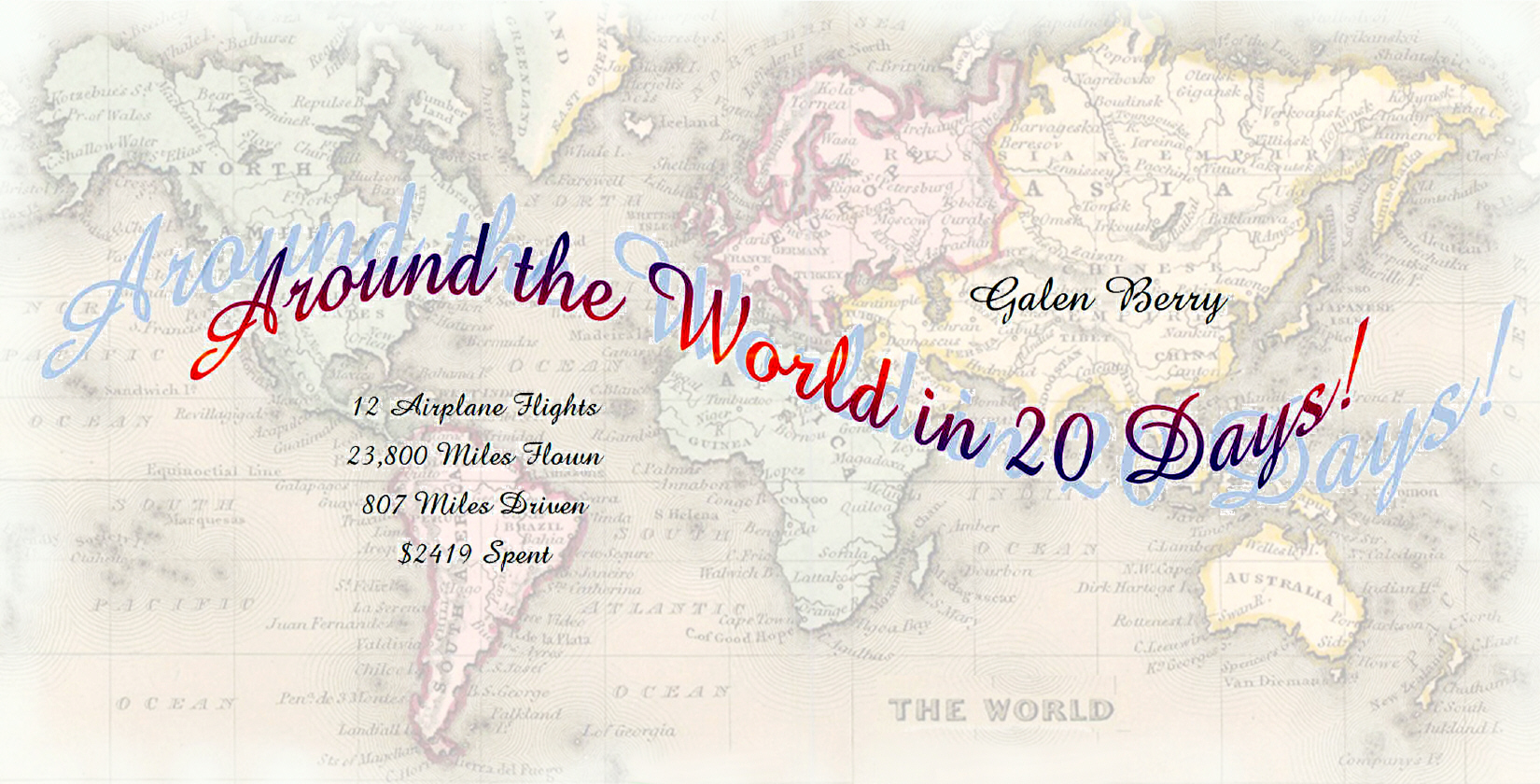
Set your screen to full size so the pictures won't be cut off on the edges.

Tuesday
August 29 – Tuesday September 19, 2017 – okay, I know that’s 21
days, but crossing the International Date Line somewhere in the Pacific knocked
a whole day out somehow; and besides, “Around the World in 20 Days” is a
catchier title than “… in 21 Days”. Hmm,
wonder if anybody else ever used a title like that….
The
main focus of this crazy trip was supposed to be the World’s Fair, Expo 2017,
in Astana, Kazakhstan. Ever since I
first heard years ago that it was planned, I knew I had to go.
I would probably never come up with another reason to go halfway around
the planet to an exotic place like that! But
as I look back on all the places I went to on the trip, I realize that Kashgar, China, was the
one that
made the biggest impression. And I
almost didn’t even go there.
I
had gobs of free air miles saved up, since I charge everything that I buy for my
business on a credit card that gives me free miles on American Airlines and
several of its affiliates. The idea of going clear around the world hadn’t crossed my
mind yet, though.
I could get to Astana easily enough on Etihad, through Abu Dhabi, but I
didn’t want to just turn around and come back the same way, especially since I
figured one 16-hour flight would be enough of a killer.
I wanted to come back through Europe for a few days.
The only other airline from Astana I could qualify for was S7 Siberian
Airlines, which could take me through Moscow to Germany.
But you’re not allowed, inexplicably, to fly from Kazakhstan through
Russia without a transit visa, even though you can from just about any other
country on the continent. Several calls and emails to two different Russian consulates all got totally
ignored, so I said forget them – since I’ll already be halfway around the
planet, I might as well just keep on going east and circle the whole globe.
With a few side trips, of course.
Just over the border from Kazakhstan in far western China is the exotic city of Kashgar. I didn’t know much about it, but I knew that in the mountains to the north of the city is one of the largest natural arches in the world. Since I have been to over 300 natural arches and bridges over the past 30 years, an idea started to form… why not try to go see it? I would probably never be anywhere near it again in my life – this was my chance.
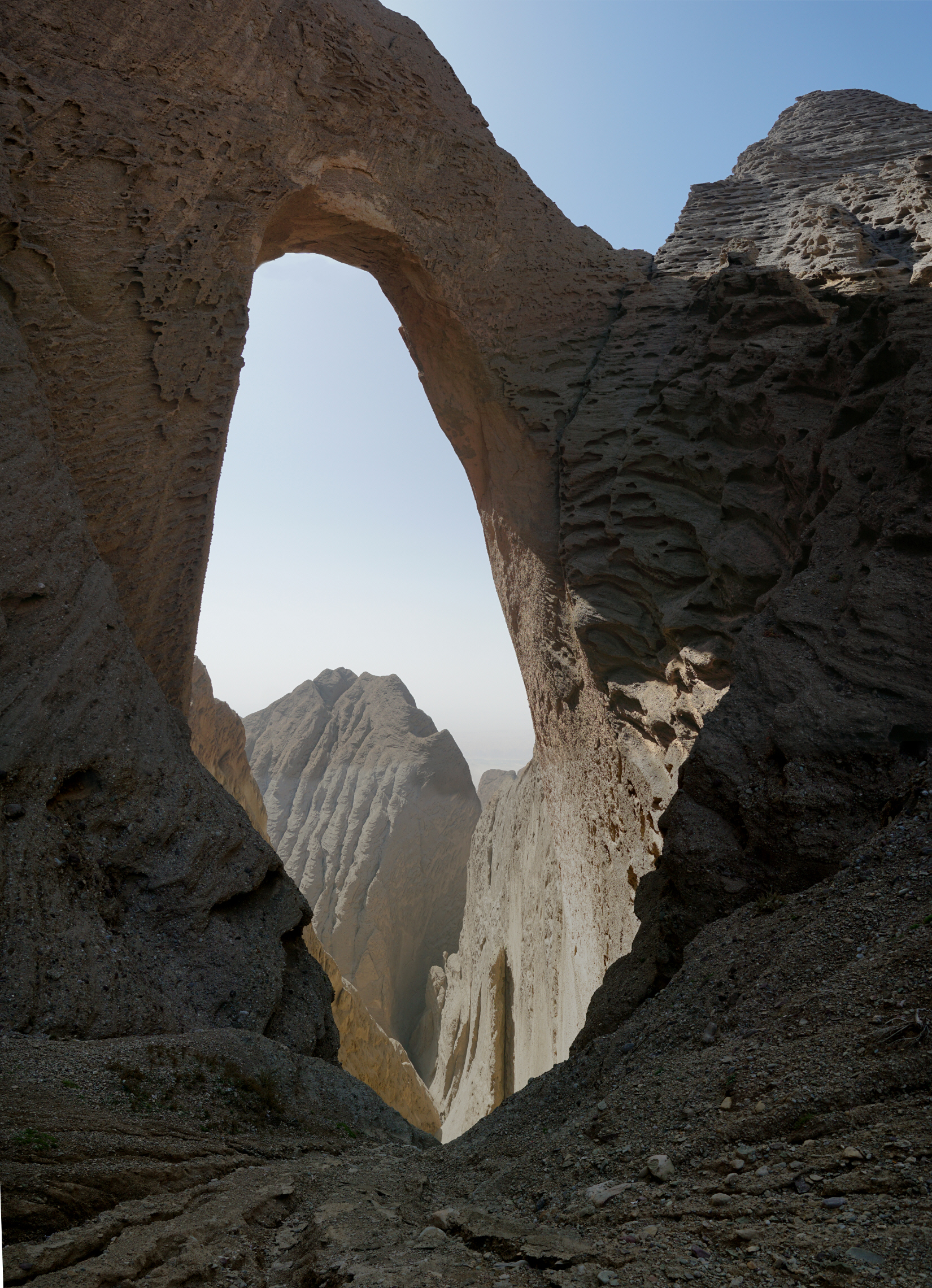
I
would need a visa for China, of course – you can’t just wander into the
country with a mere passport like you can to Japan, Korea, or even Kazakhstan.
What an annoying hassle that turned out to be.
To apply for it myself would involve driving to Houston, 450 miles away,
giving the Chinese consulate my passport, the application, and $140, going home
again, then going back 10 or so days later to pick it up (if they approved it).
They don’t do mail orders, for no good reason.
The alternative was to pay a visa service company in Houston to do it for
me – I would send them everything, and they would hand-deliver it to the
consulate, then pick it up when it was ready and ship it back to me by overnight
FedEx (an unnecessary expense, I wasn’t in a hurry).
And it would cost $270 – unrefundable if China decided not to give me a
visa. There was a real chance that I
would be refused, for sure. Any
ordinary tourist enters the country at Beijing or Shanghai; that would arouse no
suspicion at all. But here I was, an
American wanting to go from Kazakhstan in Central Asia into the westernmost
province in China, Xinjiang – their most rebellious, restive province of all,
a place with a great desire, like
Tibet, to break away for independence. China
has brutally squashed many revolutions there over the years.
They could easily decide my plans were not what a normal tourist does (my
plans seldom are, actually). But all
I could do was send in the application, pay the money, and wait.
It
took me 15 hours to fill out the paperwork.
They wanted proof that I had flights into and out of the country, and
they wanted to see receipts for all of my hotel reservations clear across the country.
But why on earth would I want to go to all the trouble of making and
paying for plane and hotel reservations, if I didn’t even know for
sure they would give me a visa? That
was crazy. But there was no way
around it, it’s just what you have to do.
Finally I got it all shipped off, along with my passport, by registered
mail. A few days later I got an
email saying that I had failed to send them proof of all the flights I was going
to make outside of China too, meaning things like Dallas to Abu Dhabi, or
Honolulu to Los Angeles. Why was
that any of their business?! And how
can you “fail” at something you never tried to do in the first place?
So
I sent them all that too. A week
later, I had my visa, good for the next ten years!
It’s
incredible that nowadays we can make plane and hotel reservations just about
anywhere on earth, right from our home computer, unlike the bad old days when
you pretty much had to be there and take what you could get, if anything – one
holiday night in Italy, long ago, I had to walk to 32 different hotels looking
for a room, and wound up sleeping on the steps of the train station.
But doing all that research at home takes an incredible amount of time.
For every city you plan to go to, you study a map to find the airport,
then figure out what part of town you want to stay in.
You search through dozens of hotels online till you find one that sounds
right. Then you have to figure out
how to get from the airport to the hotel, whether by bus or subway or train, and
exactly where to go outside the airport to catch it, how to get a ticket and how
much it will cost, where to get off and what direction to head and how far to
walk to the hotel. All of this takes
hours of research, for each city. Some
people will say why not just wing it? Figure
out the transportation on the spot. But
no, no way – you’ll lose hours of valuable sightseeing time, which is the
whole reason you’re there. You’ll
get steered the wrong way and get lost, because locals seldom know the local
hotels or how to get to them, and you probably can’t talk to them anyway.
You’ll get bad advice and spend more than if you researched things
ahead of time. You just have to
figure all that out at home, it makes things so much easier when you get there.
You’ll probably be tired, jetlagged, and just want to crash in your
room as soon as possible anyhow.
I
do believe I spent as much time in front of my computer at home planning
everything as the whole trip itself took.
There were hundreds of details, all of which had to be printed out,
including things like how to get to museums and restaurants, how to say common
phrases in 4 different languages, and how much each type of money was worth
compared to US dollars. I even
printed out hotel addresses in Chinese characters to show to taxi drivers, if
necessary (it sure was). I got so
sick of planning my trip that I didn’t even want to think about it during the
last couple of weeks before leaving! I
know – that is a terribly first-world problem to have, getting tired of
planning one’s vacation. But I’m
glad I did it all, because it was really neat to see just how flawlessly every
single detail went along the way – I never had a problem with any reservation or
transportation the whole way.
I
took one small bag with me. No
suitcase. Besides what I was
wearing, the only clothes I took were one shirt, some shorts, two socks,
underpants – and that was all. Every
couple of nights I would wash what I had been wearing in a hotel sink and hang
it up to dry overnight. With twelve
flights to catch, and a ton of walking to do at times, it was a great way to go.
It was funny to often hear airline or customs officials say, “That’s all
you brought?”
So on Tuesday afternoon, August 29, I set off on my grand adventure. I always hate the dinky jaunt from home in Oklahoma City to Dallas, which you have to take in order to fly just about anywhere – I can drive it quicker than flying it, and it’s totally the wrong direction anyhow from where I was going. But that’s where you catch Etihad, one of the highest-ranked airlines in the world. I didn’t find it much different from any other – the seats were as hard as everybody else’s after a few hours, and quite intolerable long before the trip was over. I was dreading that flight more than any of the twelve I had planned out, it being by far the longest I’d ever been on, and I can never get any decent sleep while sitting up, leaning on a curved side wall, trying not to snore lest I embarrass myself while sleeping. But they have video screens on the back of each seat, with earphones. I watched 3½ movies and 4 TV shows, and the time went by a lot more quickly than I expected it to. Watching the sunrise over the glaciers and icebergs of eastern Greenland was the highlight of the flight. Huh, you go over Greenland to get to the Emirates? Yes, and Labrador, Iceland and Sweden too – even though the Emirates is at a lower latitude than Dallas. That's just the way the earth curves.
The
whole trip:
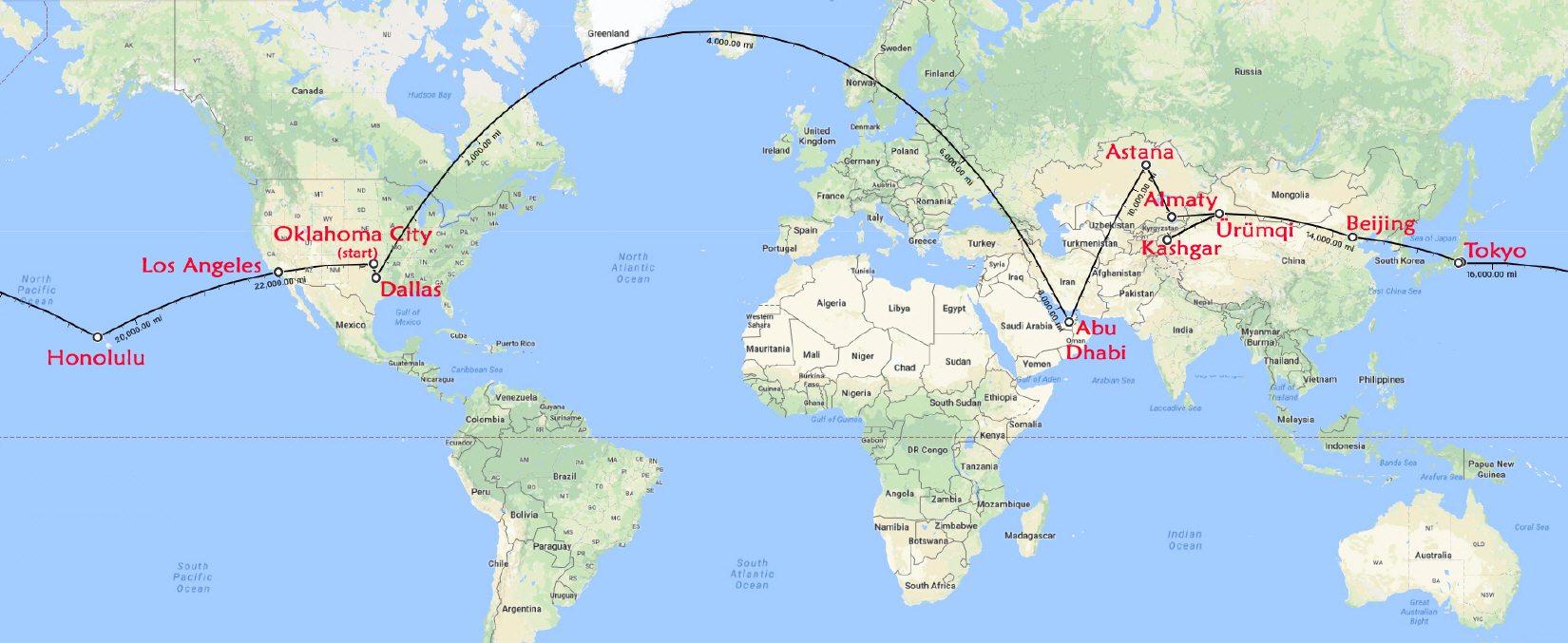
We
landed after dark in Abu Dhabi, the capital of the United Arab Emirates, and I
headed straight for my hotel, which was right inside the terminal next to the
rent-a-car area. It was quite cheap
and very convenient. I knew the next
day would be one of the best of the whole trip, and it was.
I rented a tiny Chevrolet Spark, and took off for the desert!
Any normal tourist would head straight in to the city, or to Dubai just
up the coast – but no, for some reason I headed straight to El Ain, the only
big inland town in the country, and then curved north and over the mountains to
Fujairah, the only part of the Emirates that is on the ocean instead of on the
Persian Gulf. I had a hotel reserved
in Sharjah for that night. No doubt
I am the first tourist in history who managed to go from Abu Dhabi to Sharjah
without passing through any of Dubai at all.
I always tend to do things the hard way, and sometimes the dumb way.
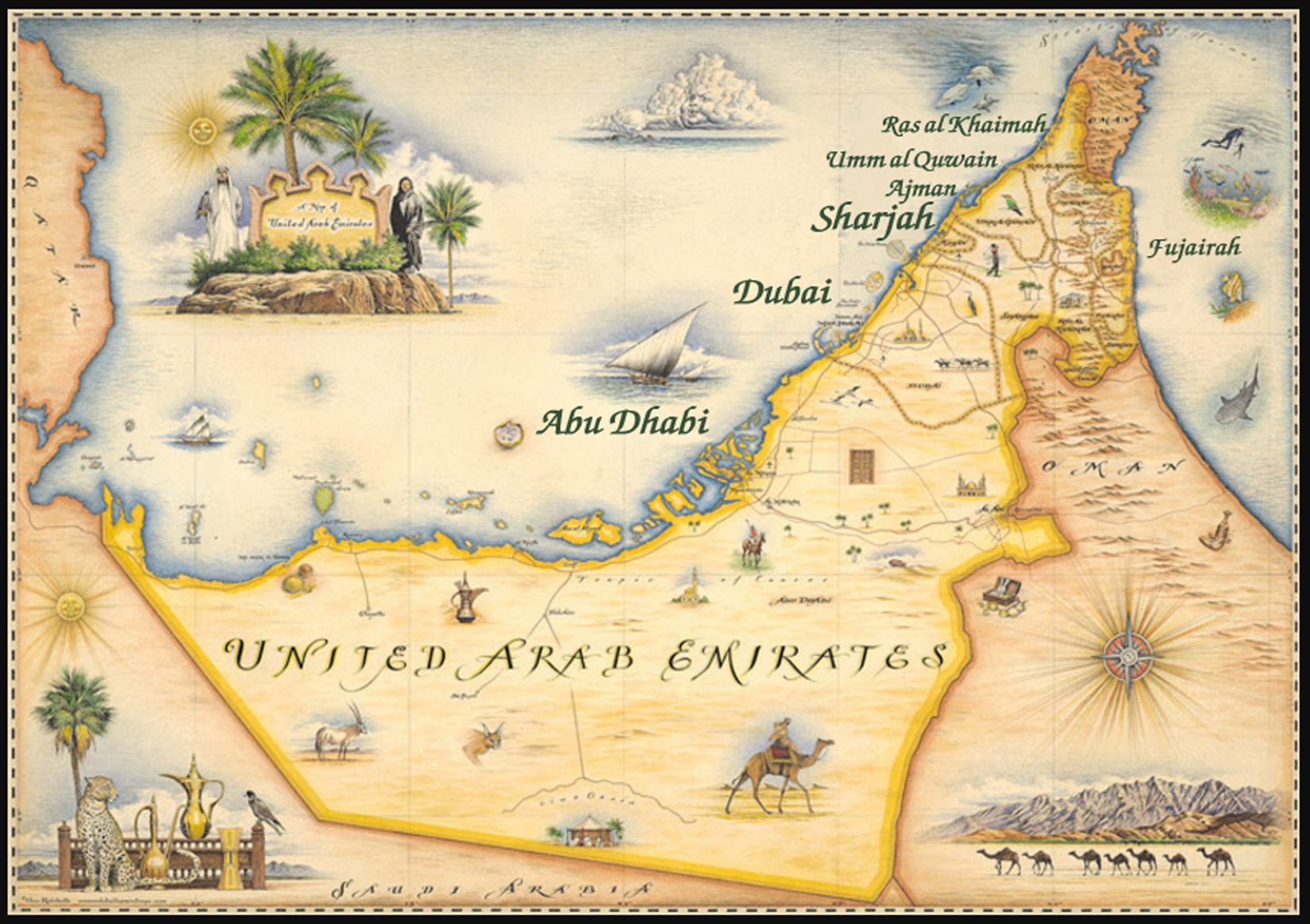
There was a reason for doing all that. I wanted to sneak into Oman, the neighboring country. You can’t take a rental car over the border, and if you do the insurance is invalid; and you’re supposed to get a visa at the border for $50 or so. But during my countless hours of scanning maps at home, I had found a place where I could get away with it all. A small road with no border guards went clear across a little chunk of Oman, quickly becoming a dirt road in the mountains, which I knew I would enjoy immensely (as long as I didn’t hit anything or get hit). Oh, you’re not allowed to take rental cars on dirt roads, either, much less on those of neighboring countries. Well, too bad.
Scenes
from Oman:
I
had a grand old time! I only got
stuck once – the little car couldn’t make it up one gravelly hill, but it
coasted down backwards easily enough. Eventually
I wound up back over the border into the UAE again.
It was getting dark as I drove up the Fujairah coast… oh how weird –
I just now realized, just as I am writing this, that that was the first time in
my life I had ever seen the Indian Ocean – the third largest ocean, after the
Pacific and the Atlantic! Strange,
the things you discover when going over a trip in your head!
Then I turned west and started the long drive to the hotel in Sharjah. I made it by midnight. Out of the seven emirates that make up the country, Sharjah isn’t as well-known as Dubai and Abu Dhabi. But it is very rich, with a large population, and an incredible assortment of skyscrapers and of course a grand mosque.
Driving around the next morning, I ran across this row of beautiful government buildings, all in a row, in an exotic modern Middle Eastern style of architecture. Even though Sharjah is only the third-largest of the seven emirates (about two-thirds the size of Rhode Island), its impressive public buildings would be the envy of many a whole country.
The
Petroleum Council Building:
The
Electricity and Water Building:
The
Town Planning Building:
The
Sharjah Real Estate Department:
The
Government Media Bureau:
The
Sharjah Finance Department:
The
Sharjah Court House:
I wanted to hit all seven emirates. So the next morning, I headed north through Ajman (the smallest), Umm al-Quwain (the poorest), and Ras al-Khaimah (the prettiest). As usual, I found myself doing the opposite from any sensible tourist – instead of hitting the glamorous cities of Dubai and Abu Dhabi, I headed straight for the Old Town in Umm al-Quwain, the only part of the whole country that could be considered a slum. It is populated entirely with foreign workers, mostly from India, the Philippines, or Egypt – the men who build the skyscrapers and do all the dirty work outdoors in the ghastly desert climate. I had heard horror stories of how awful their living conditions were, but the place actually looked kind of fun to me. The guys were hanging out in the streets by the hundreds, playing games in the park, eating at sidewalk cafés. I never saw a single woman in the whole town; a few of the guys were carrying babies, so I guess there were some hiding somewhere.
With only two days in the country, I knew I’d better get on south to the spectacular city of Dubai soon, though I wasn’t looking forward to traffic, toll roads, and impossible parking. But I had to see the tallest building on earth, the Burj Khalifa. It really is magnificent, though I had no desire to pay $40 to go to the top and see the view on a hazy day.
See
anything unusual here?
How
about here?
Here's
a close-up of it!
Emirati
men in their dishdashas –
all with cell phones:
Any look at a map of Dubai will provide a bizarre surprise – the Palm Islands. Obviously artificial, they are made of tremendous quantities of dredged sand, with giant hotels and condominium blocks, and hundreds of mansions selling for many millions of dollars, each with its own little bit of beach. I had to go, of course. They are even much larger than you would expect. I was disappointed that you can’t get out onto the “fronds”, they are all gated communities; but I did make it to the magnificent Atlantis resort, at the very farthest end of the islands.
(I
copied these three aerial shots from Google Maps.)
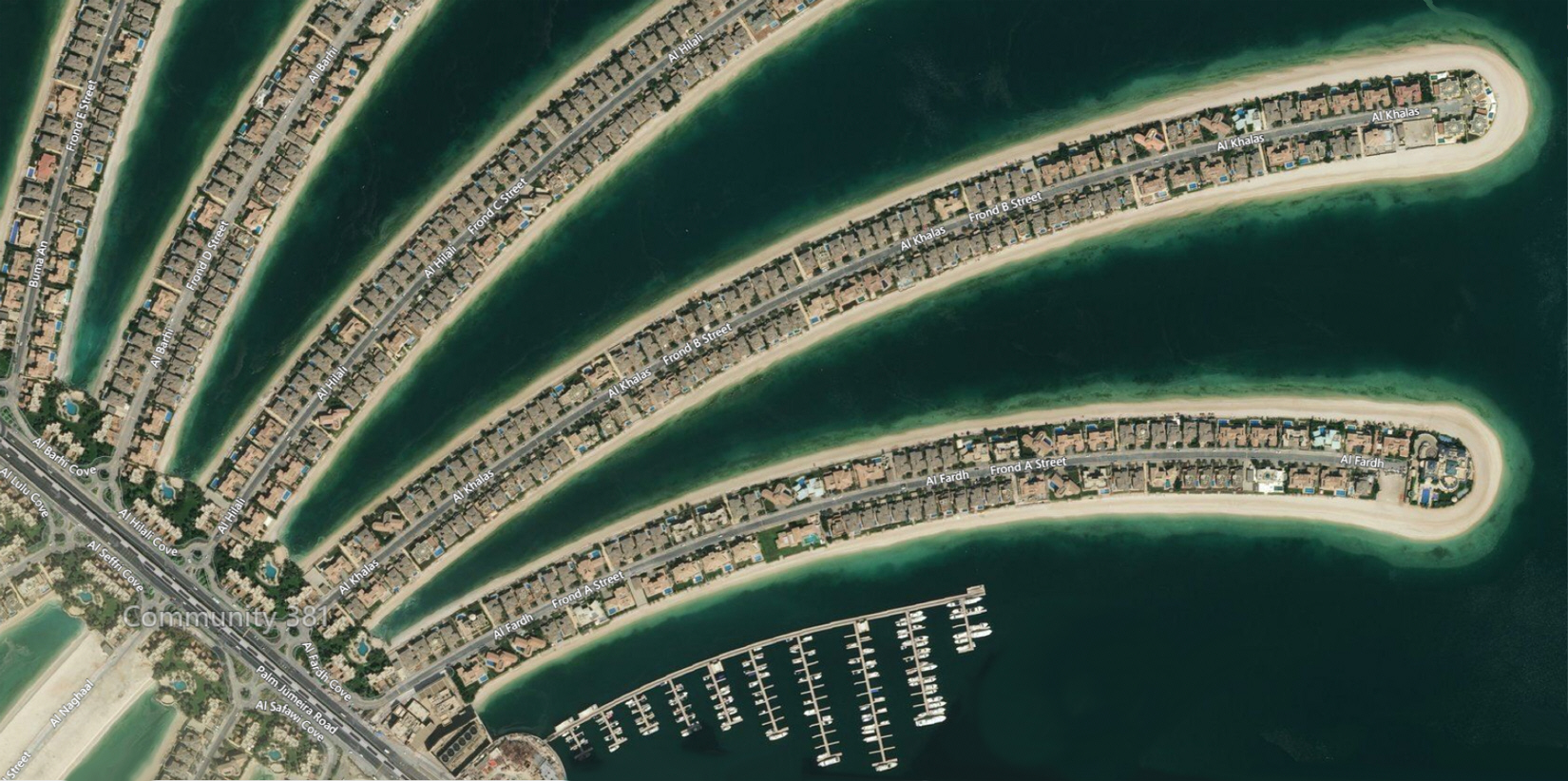
The
Atlantis resort:
Distances
are larger in the UAE than you might think from looking at a map.
I drove over 600 miles, and never did make it into the actual city of Abu
Dhabi, perhaps the richest city on earth – I just stayed again at the airport
hotel, since I was flying out in the morning.
I had packed a lot into two days. Maybe
I’ll come back for the next World’s Fair in 2020!
The
jump on Etihad from Abu Dhabi to Astana, Kazakhstan, was uneventful, though
flying over Iran was interesting. I
had window seats on every single flight, the whole trip – I can’t understand
anybody being so uninterested in the world as to never even bother to look out
over where they’re going. I’m
always so glued to the window that I have a neck-ache after every trip for
hours. Latitude-wise, it’s like
going from Miami to Winnipeg. But
even Astana, the second-coldest capital city in the world (after Ulan Bataar),
was hot, though certainly not 106° like Dubai had been.
I could easily see the World’s Fair grounds from the air – the main pavilion is the largest spherical building on earth, eight stories tall. I had rented a whole apartment for four days, a beautiful little place in a new building, super cheap, at walking distance from the fair. The next morning, waking up early because of the advanced time zone, I was nearly the first person there and had to wait an hour for the fair to open.
Expo 2017
World's Fair:
I had been to a couple of World’s Fairs before, back when we still used to have them in North America (the last one was Expo ’86 in Vancouver). But they have been having them every few years, very successfully, in other parts of the world ever since 1865. Kazakhstan, despite being one of the 10 largest countries on earth, is hardly known to Americans, though like the Emirates it is very oil-rich and they have done an incredible job of modernizing their country and educating their people. This World’s Fair, called Expo 2017, was their chance of showing off to the world, and they spent billions on it. They did a spectacular job.
Some of
the national pavilions –
Germany, Monaco, Spain, Greece, and Luxembourg:
Pavilions
for Argentina, Sri Lanka, and Russia:
Austria,
Finland, Hungary –
and a Rolls Royce!
The USA
pavilion, right next to the Vatican and Poland:
Qatar,
Slovakia, and Romania:
Israel,
Korea, Viet Nam and Japan:
The pavilion of Kazakhstan
-- world's largest spherical building:
Inside the Kazakh
pavilion, looking down through the eight levels:
The scary glass walkway in the
Kazakh pavilion that looks down through all eight floors:
A giant machine inside the
Kazakh pavilion, powered by human feet! You can watch an amazing video I
took of it in motion -- click
here.
The
theme of the Expo was “Future Energy”, meaning how the world will get energy
when we can no longer depend on oil and gas, even though that’s exactly what
Kazakhstan became rich on. There
were lots of exhibits on solar panels, wind turbines, electric cars, and wave
and tide power. 115 countries
had set up pavilions, more than they had even predicted would take part.
The giant ball-shaped building was Kazakhstan’s own pavilion, by far
the best one there. The USA was set
up right next to the Vatican for some reason.
Germany and Korea were two of the most popular ones.
There were some large omissions –
Brazil, Australia, Indonesia, and Canada were
absent. But why were places like
Somalia, Venezuela, and the Central African Republic there? They’re
in the middle of civil wars back home! Even
though Kazakhstan had done a bang-up job of building the place, what let them
down a bit was that some of the other countries didn’t try very hard in their
pavilions. They seemed to think that
hanging up a few posters of solar cells and windmills from their countries was a
decent display, but it got old – a wind farm in Djibouti looks pretty much
like a wind farm in Tajikistan.
There were droves of people there on Sunday, though Monday was a lot calmer. A whole arena had been set up for the Cirque du Soleil, but it was sold out every night and I couldn’t get a ticket. It seemed like I was just about the only American at the fair. I went into the USA pavilion just to get to talk to someone in English for the first time in a week. But people sure came from everywhere else; I even recognized two guys from the tiny Pacific island country of Tuvalu who had been on my plane. Every country represented at the fair got to have one day when it could put on a program in the auditorium. The guys I had met were in costume doing folk dances!
Dancers
from Tuvalu:
A timeline of all the World's Fairs –
they
have been held every few years since 1851:
As soon as you exit the Expo, you find yourself inside an enormous brand new shopping mall, called the Silkway. Lots of the stores and restaurants are familiar, though with Central Asian decorations like camels on the wall that you would hardly find in a McDonald’s at home!
The
exotic looks of the Kazakh people, whose language is similar to Turkish:
After two days at the Expo, I decided to spend a whole day exploring the city of Astana. Until the 1990’s, the city hardly existed. The capital of Kazakhstan was Almaty, which was smack on the southern border. Even though Almaty was the largest and most important city, they decided a capital in the interior of the huge country would be more appropriate. So, with the country’s vast oil money, they built a spectacular new city from the ground up. It has been a huge success – it became the capital in December 1997, and now has more than a million people in it. The name, pronounced a-sta-NAH, not a-STA-na, simply means “capital” in Kazakh. It is quite an architectural showpiece, and the people seem well-off and highly educated. Though supposedly Moslem, fifty years of communism when it was part of the USSR pretty much knocked the religion out of the people – I only saw two mosques in the whole city, whereas the UAE seems to have about one every square mile. They dress exactly like us, or like Europeans; the girls, very stylish, would never dream of wearing a headscarf. The country is determined to rise in importance and influence in the world – their brand new Nazarbayev University, named after the president, right across the street from my apartment, has recently decreed that all classes must be taught in English.
Beautiful
downtown Astana:
The Baiterek Tower:
Looking through the Gas
Company building, with the Baiterek in the distance:
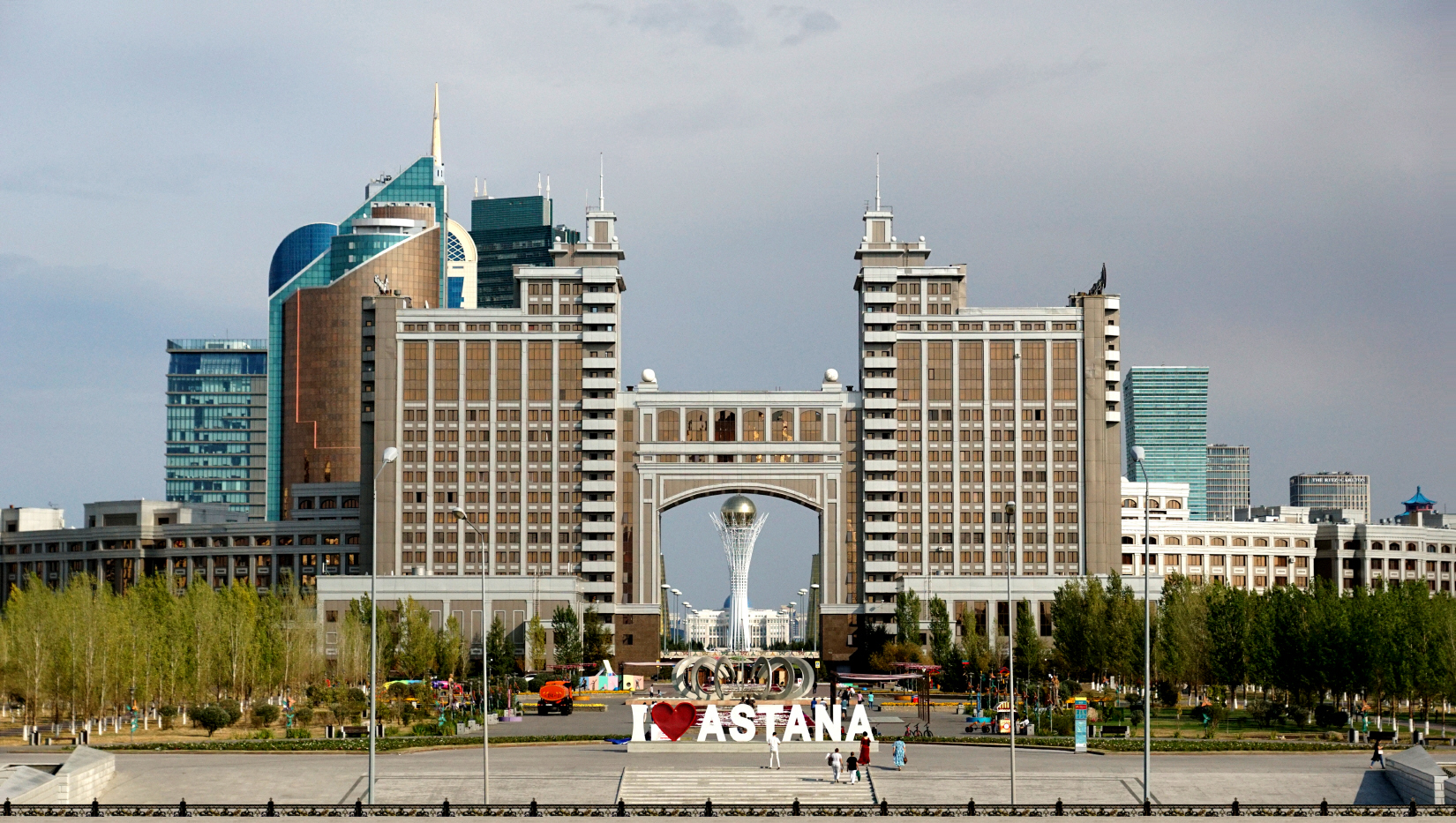
Looking the other way
through the Gas Company, with the Khan Shatyr Mall in the distance:
The Astana Opera and
Ballet Theater:
Looking through the columns of the opera
house to the Khan Shatyr Mall:
At the Khan Shatyr Mall:
The mall is five stories
tall inside:
Nazarbayev University,
named after the President of Kazakhstan, where all classes are in English:
The central mosque of
Astana:
New apartment buildings in
Astana:
The Triumph Apartments
building in Astana, inspired by the old Stalinist buildings of Moscow:
More buildings downtown:
The Concert Hall:
The Presidential Palace is
in the distance, between the "beer cans".
After riding busses and walking for miles taking pictures, I headed for the beautiful Presidential Palace, which can be considered their capitol building. It was getting late, and the building was too dark for pictures. I figured it would probably be lit up at night, so I sat on a bench in front and waited. Precisely at 8 o’clock, the floodlights came on. The area was oddly deserted – no cars were allowed on the huge streets all around it, and only two or three other tourists were even in sight. One lone guard was walking back and forth across the property, far away from me. I wondered if I wasn’t even supposed to be there. But I started taking some pictures with a flash, to light up the flowers in the foreground. Immediately the guard started heading my way. Oh no! I knew some of these exotic countries have major rules against taking pictures of government or military buildings, and they can actually confiscate your camera film or photo chip. As quick as possible, I took the chip out and stuffed it way down in my pocket, and put a blank one in – I already had way too many pictures on there to lose. But I soon realized that he was walking too slowly to really be very concerned. When he got to me, all he did was ask if I had a cigarette! We talked a bit, in fractured English, then he wandered back off to resume his pacing.
The Presidential Palace
(and the security guard):
Goodbye to amazing Astana!
The next day at noon, I got on the charmingly named SCAT Airlines and flew to Almaty. What a contrast – it has fine modern buildings too like Astana, but it also is an ancient place, a grand old Silk Road city, and has a much more lived-in feeling than Astana. The weather there can range across the year from 110° to 36° below zero. My little hotel was just a block from the famous Abay Opera House. But the main thing I wanted to see there, their amazing old Zenkov Cathedral, was totally covered in scaffolding! It will be magnificent when it is restored, but looks pretty awful right now.
The Abay Opera House in
Almaty, Kazakhstan:
The Zenkov Cathedral in
Almaty:
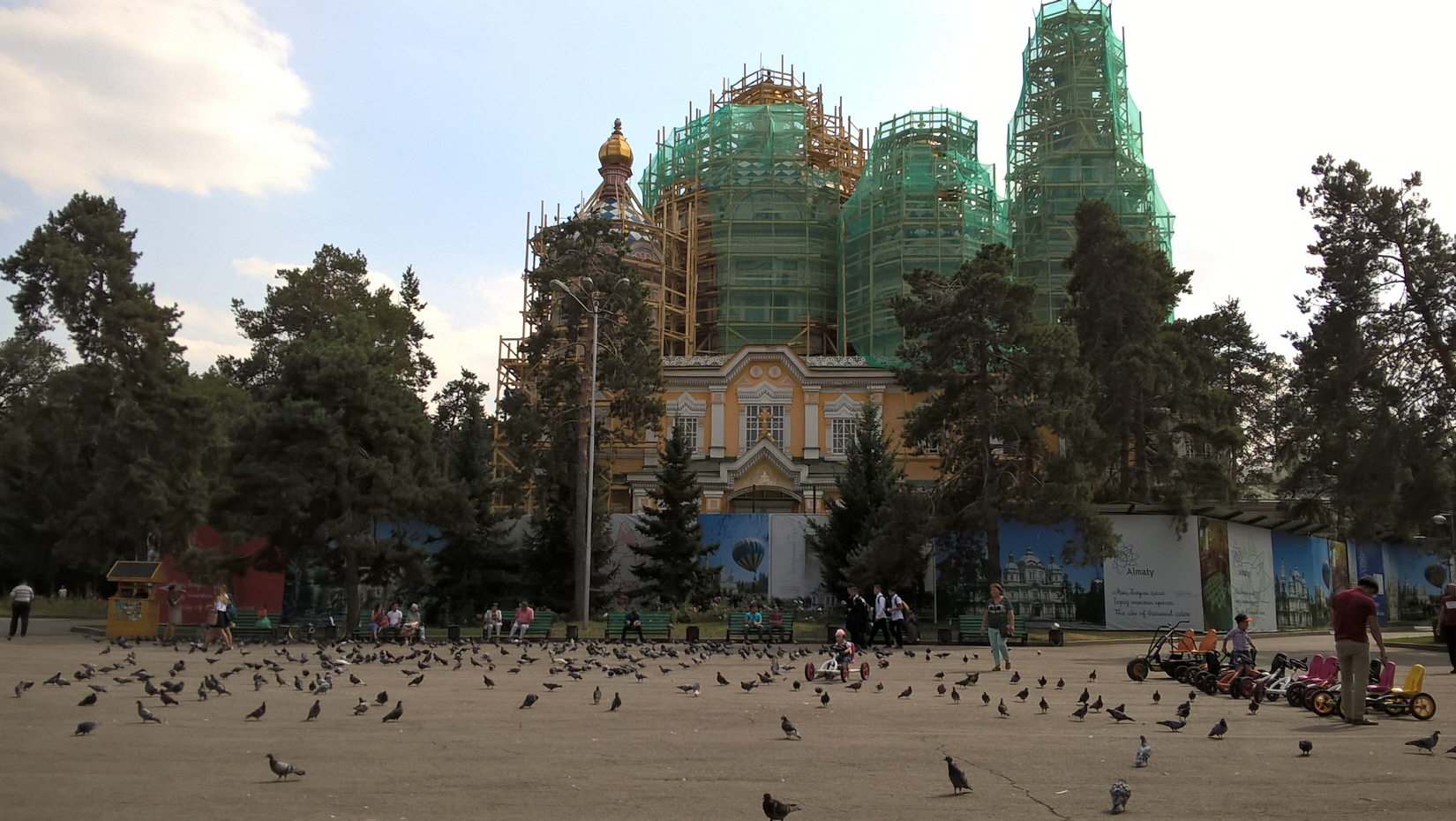
I headed for the famous Green Market the next morning, an amazing display of food. The name Almaty means “Father of Apples”, since apples were first domesticated thousands of years ago in the area. So of course I had to get one, and it was good.
In the
Green Market of Almaty:
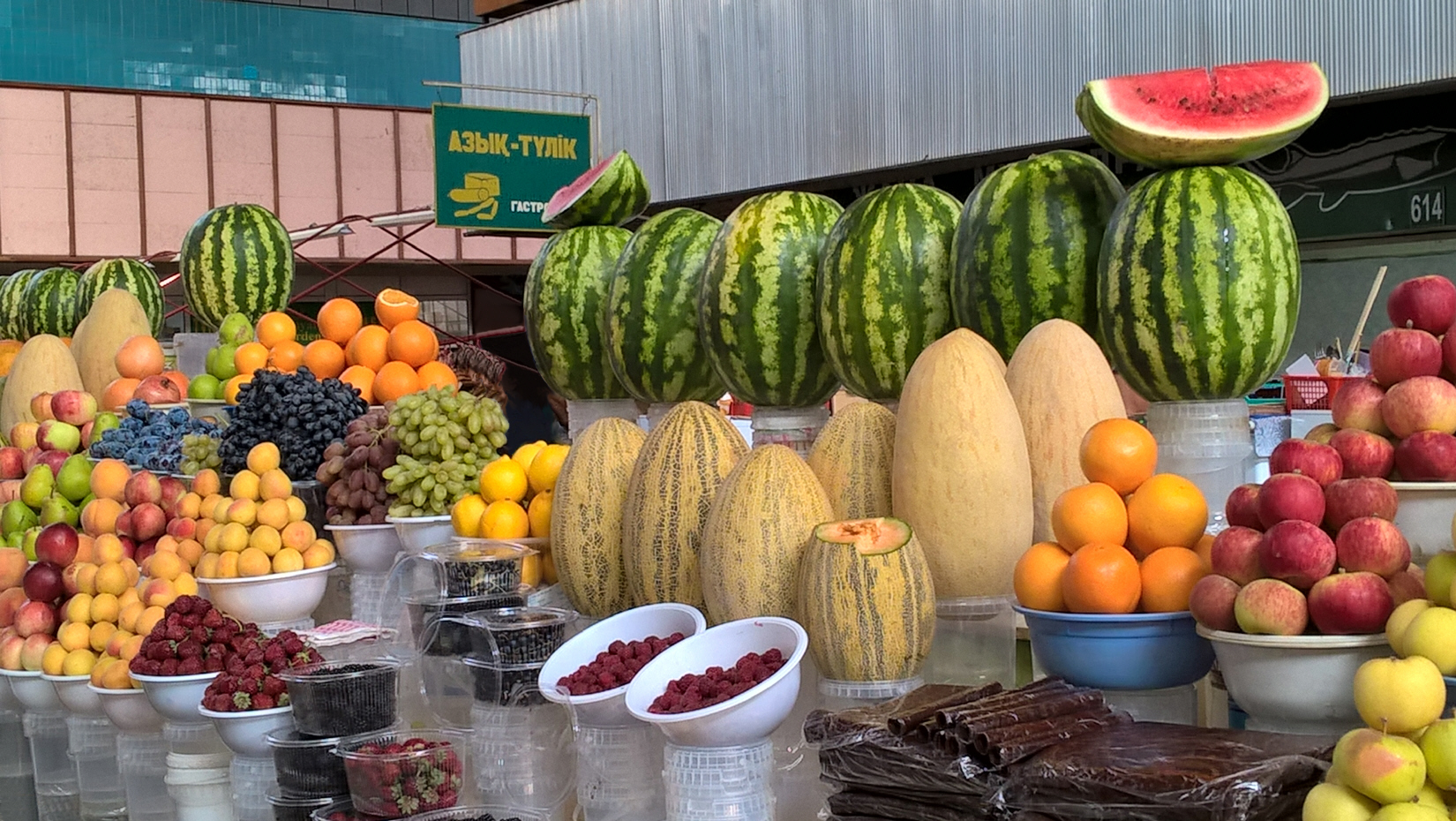
The
great apples of Almaty:
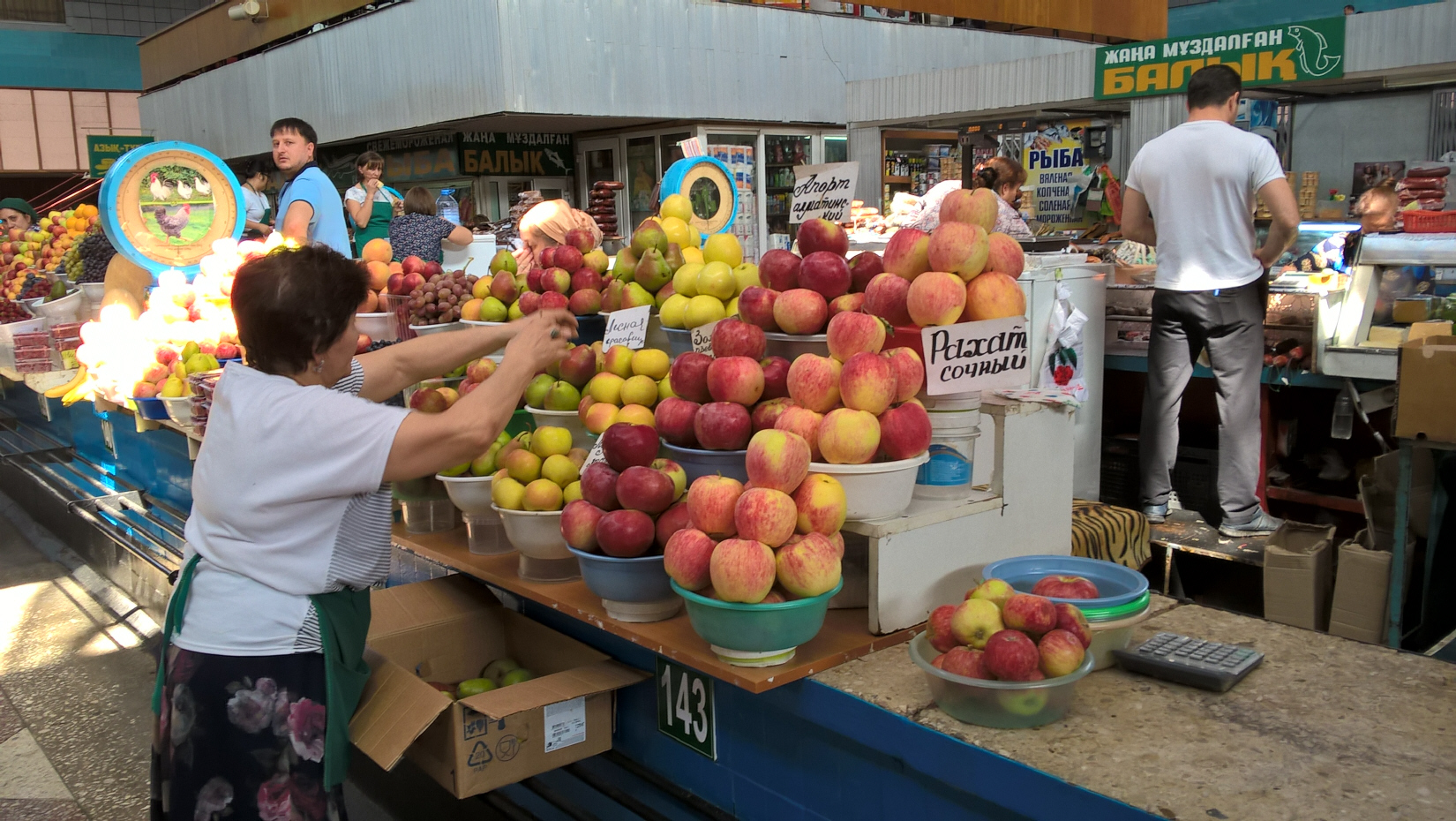
The
famous spices of the Silk Road:
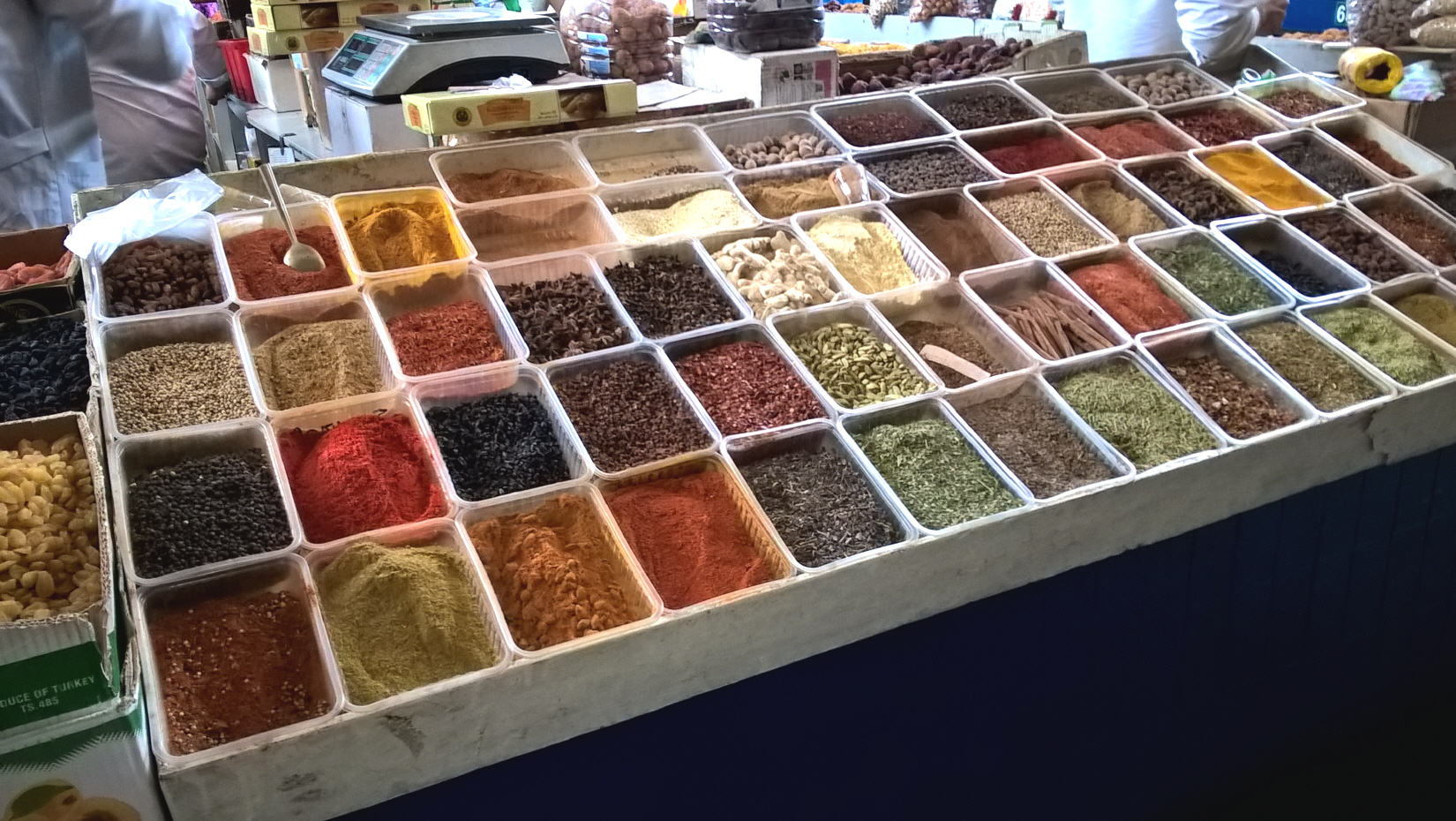
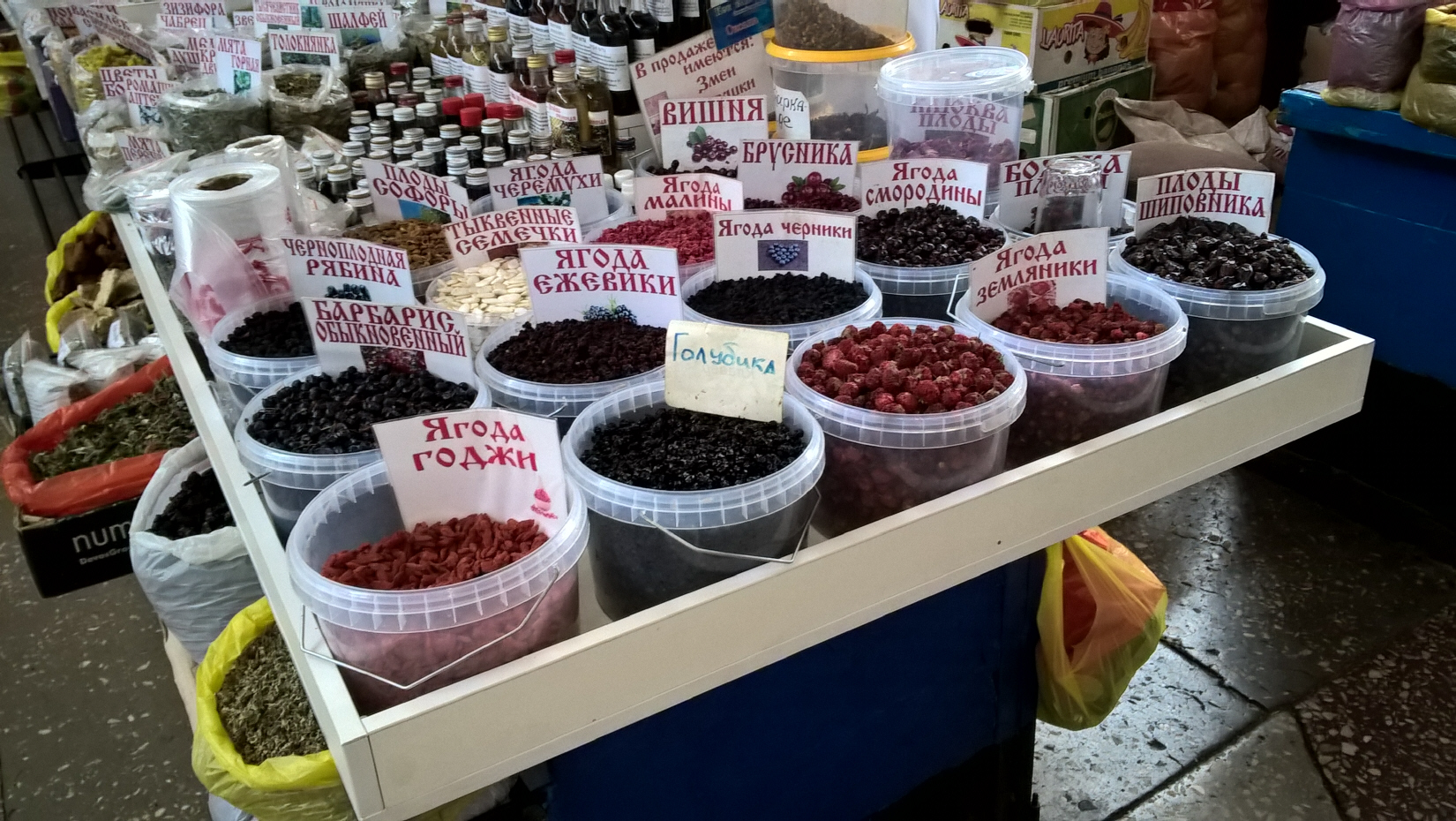
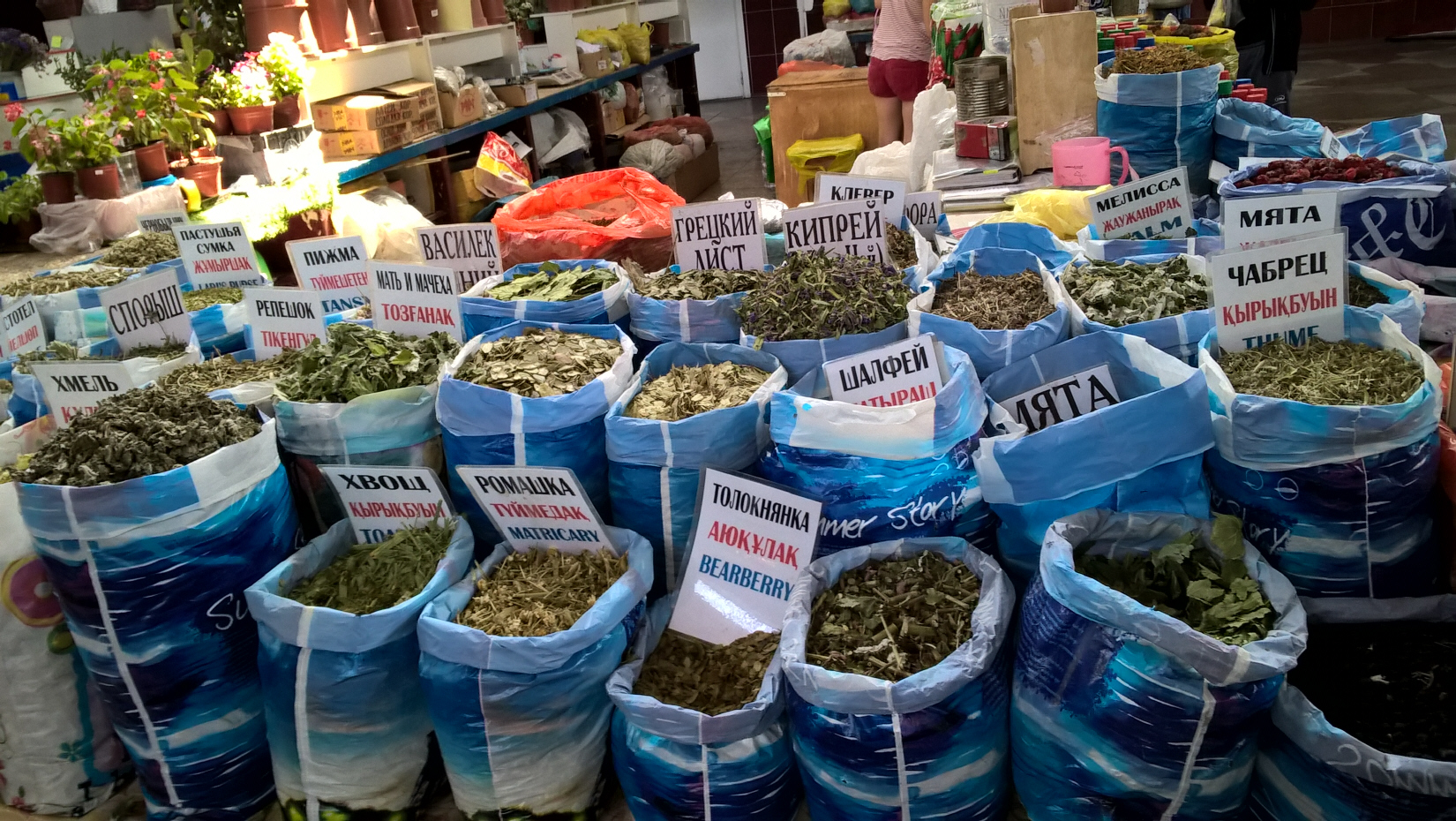
Of course I had to hit the
cheese aisle:
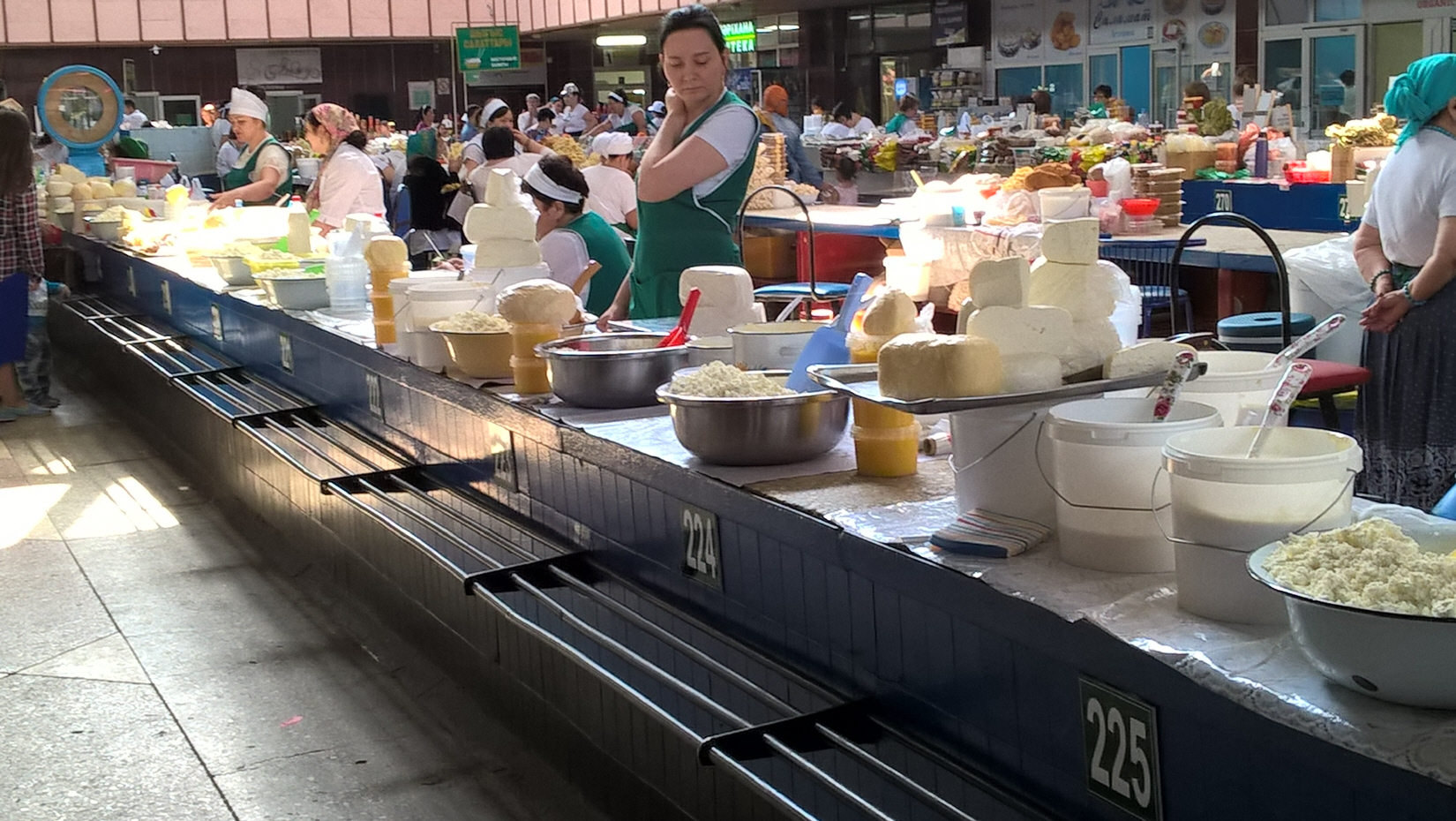
As the sign shows, here is
the aisle for sheep meat:
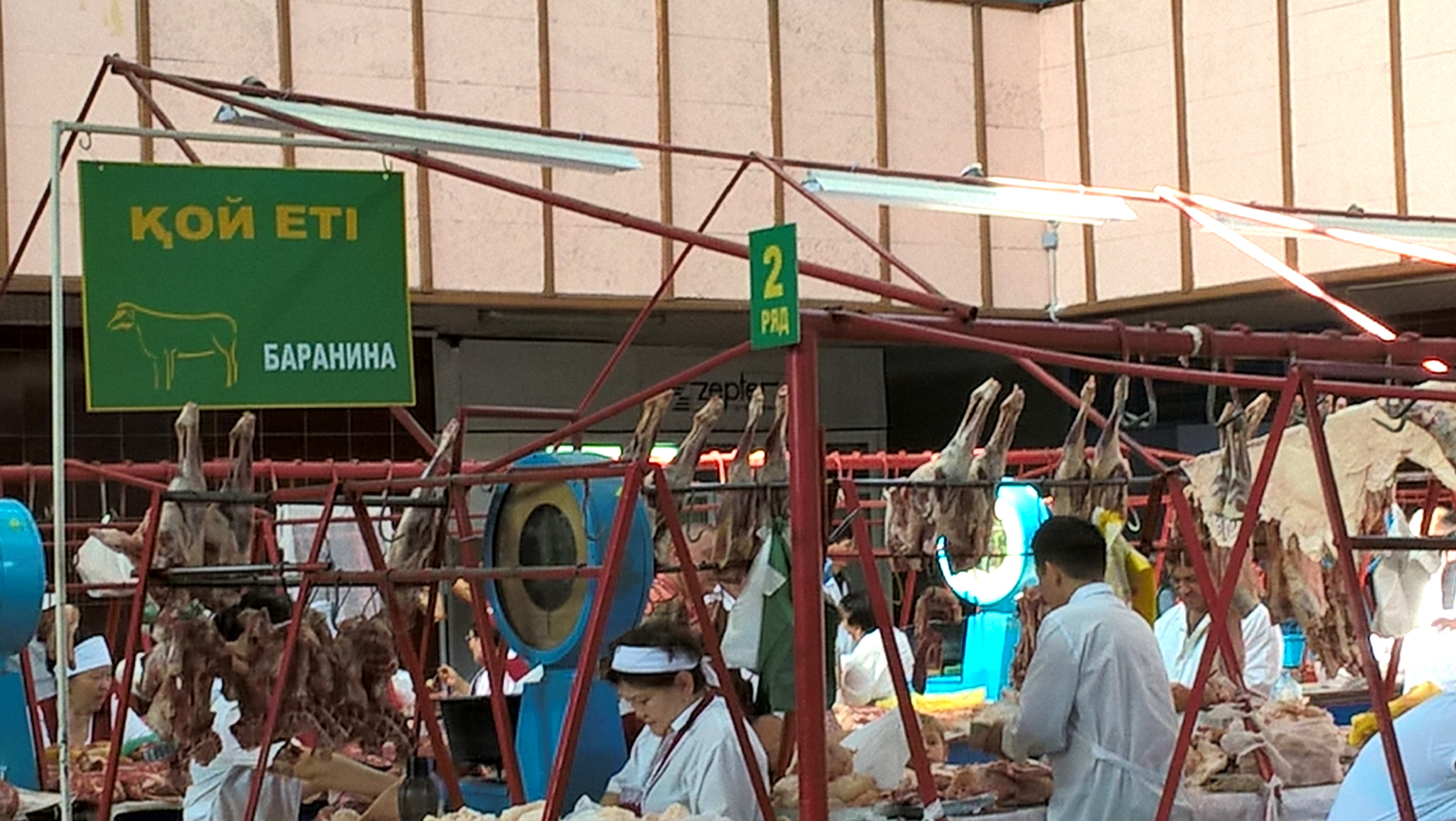
Here is the aisle for cow
meat....
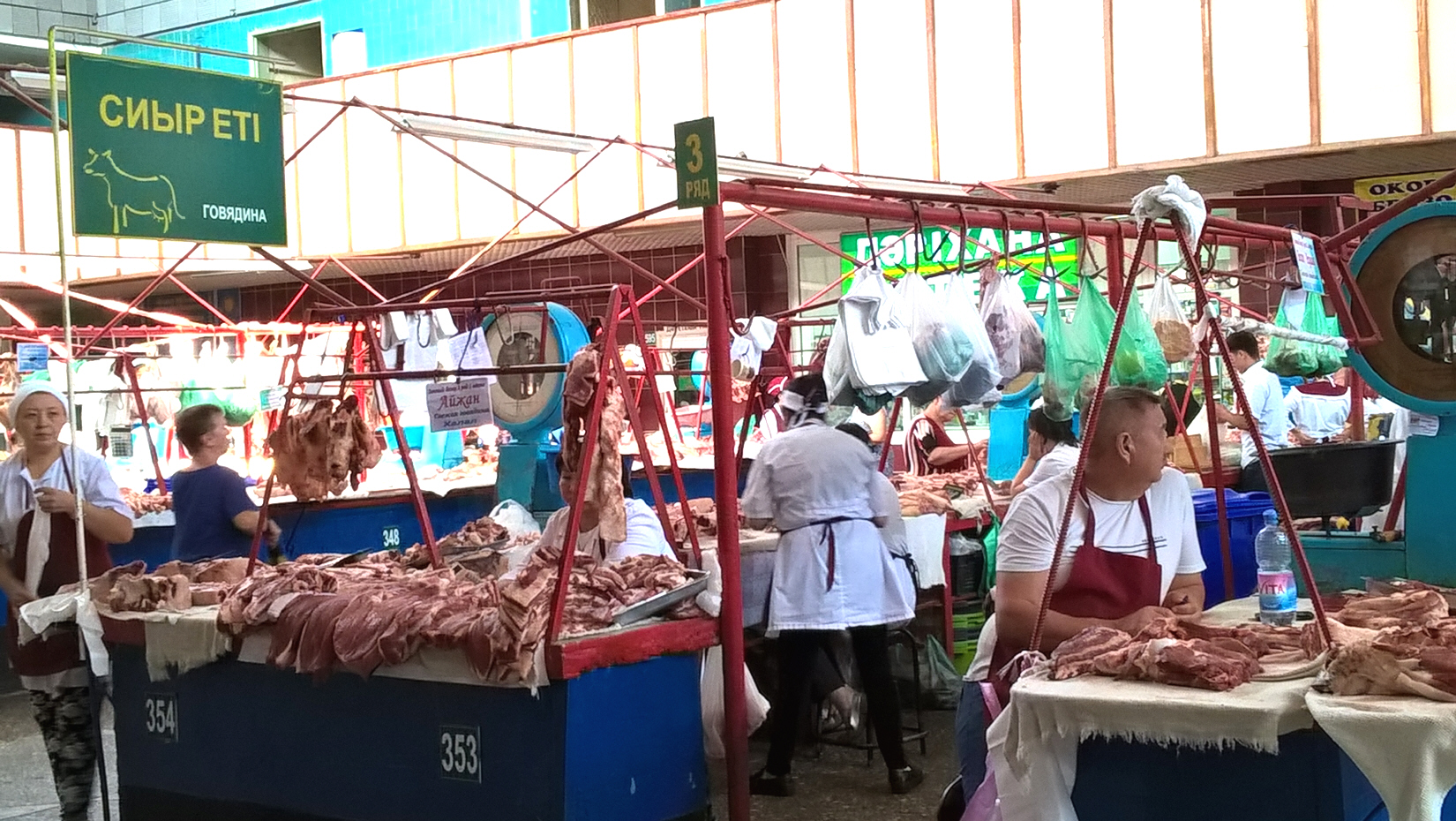
And of course –
horse!
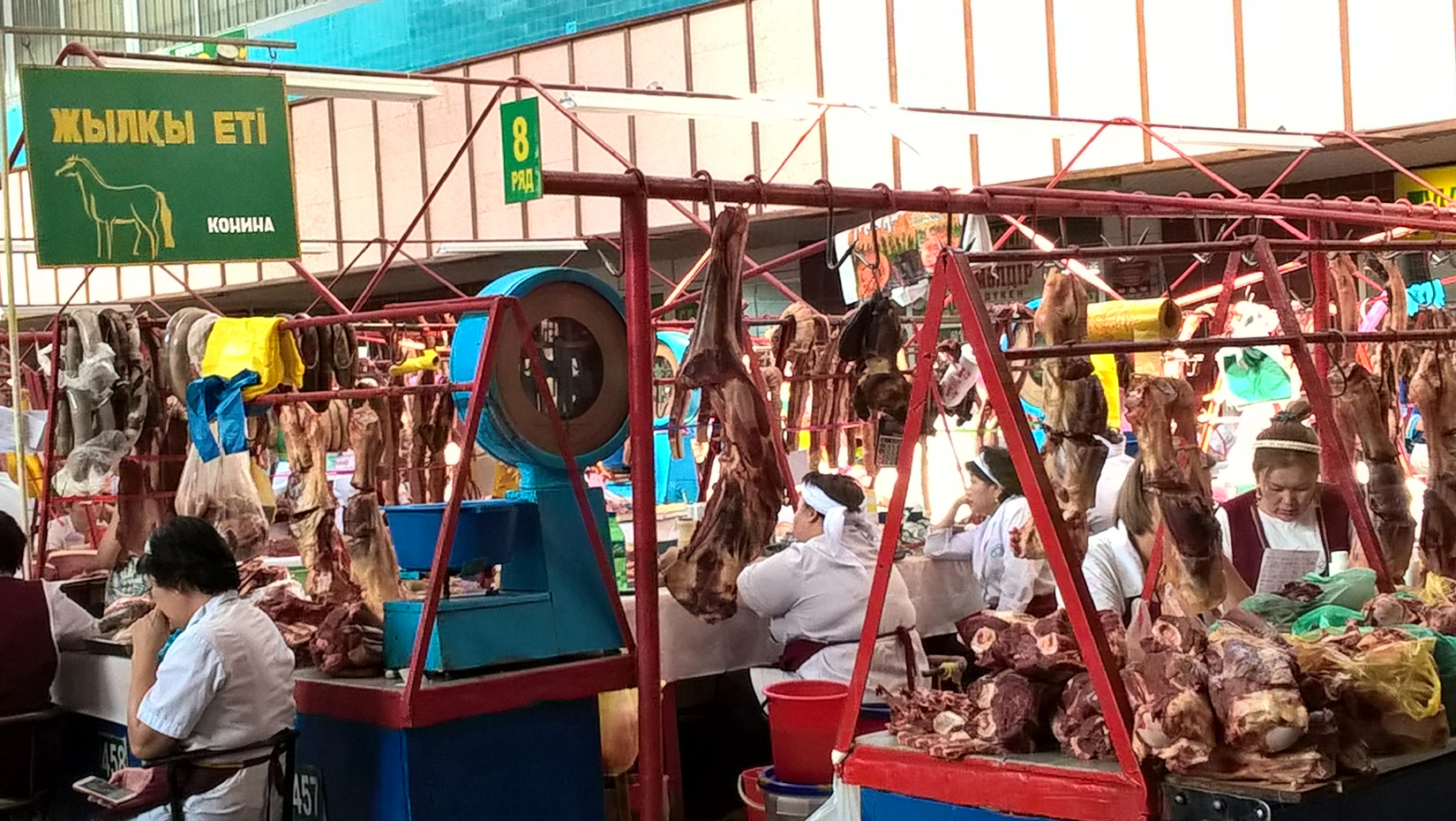
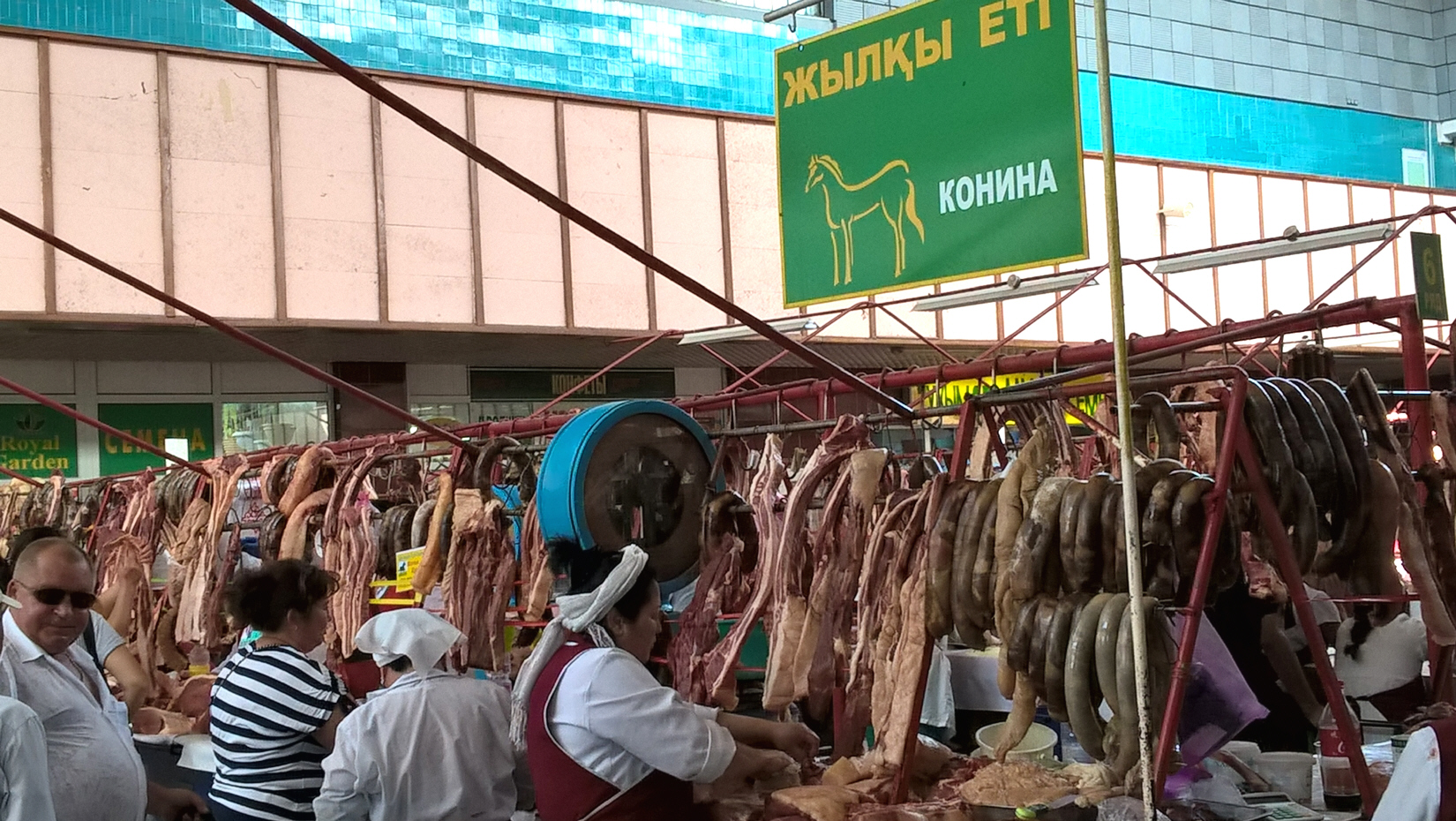
Need
some milk?
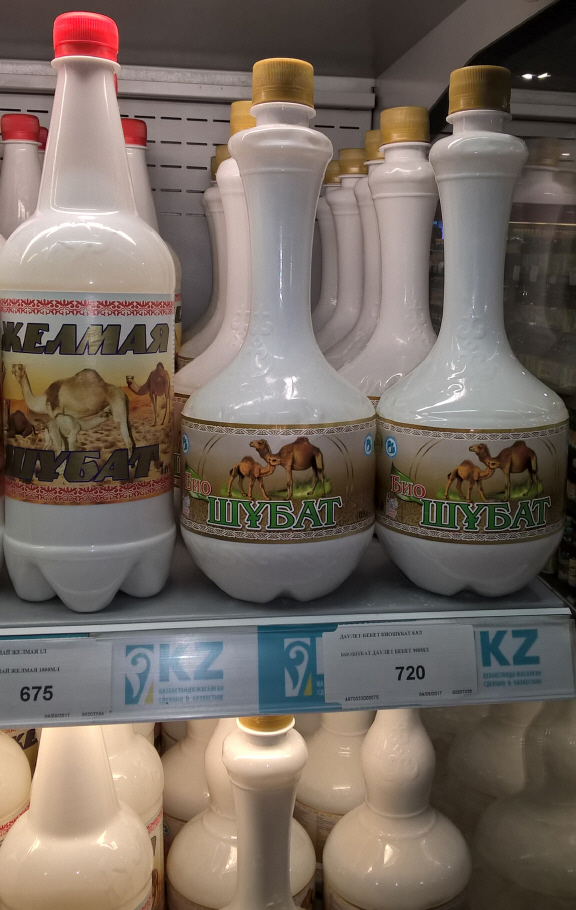
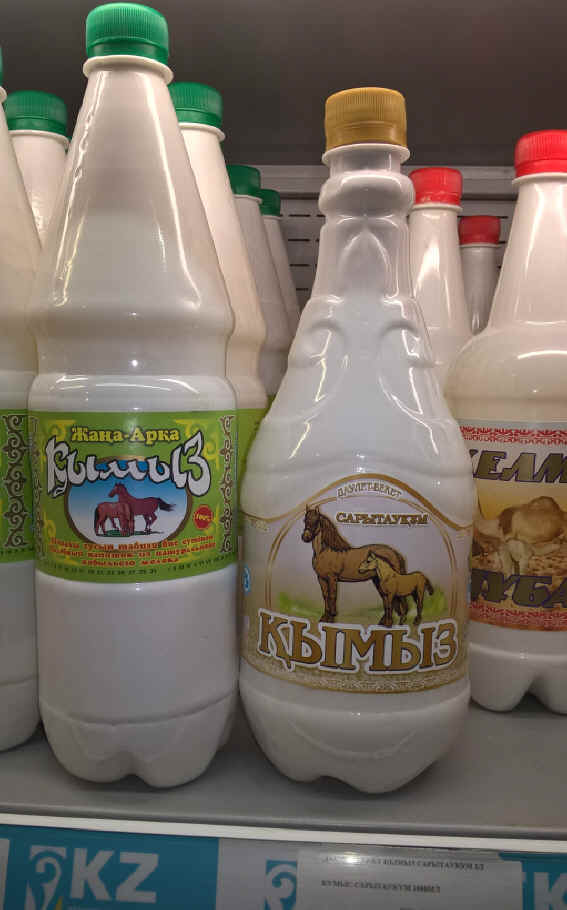
I took an aerial tram lift up to a mountain top for a great view of the mountains to the south of the city. The whole city is on a definite slant, being on the very edge of the enormous Tian Shan range – if you’re walking uphill, you’re heading south. Knowing that comes in handy when you’re lost.
View of
the Tian Shan foothills from the highest point in Almaty:
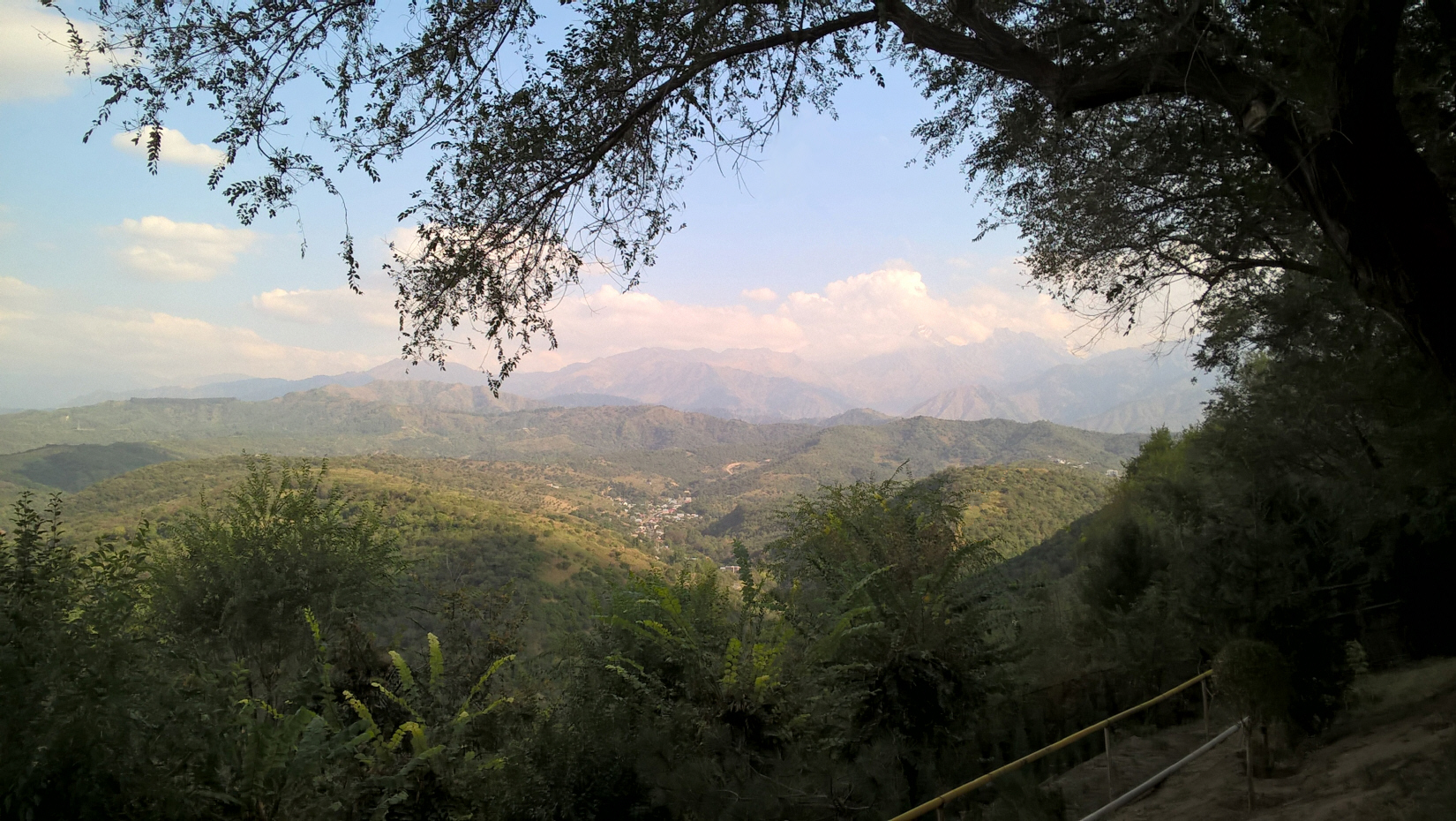
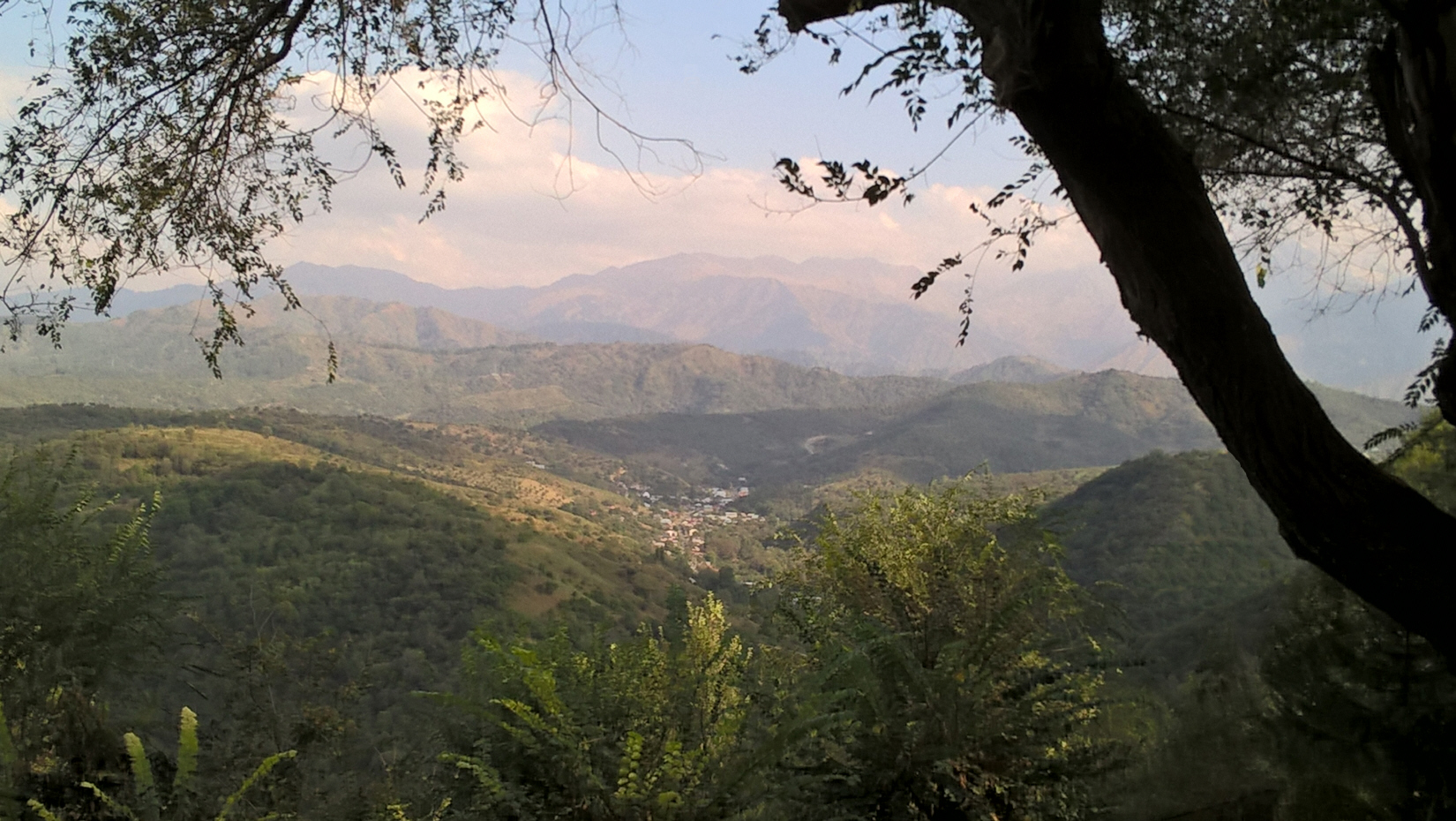
I
didn’t have much time in Almaty. The
part of the trip I dreaded most was coming up, that very night – the flight to
Kashgar. You
can’t just fly the 260 miles straight south from Almaty over Kyrgyzstan to get
there. You have to fly 540 miles
east to Ürümqi, China, arriving at 1:30 a.m., spend 6½ hours desperately
trying to get some sleep on benches in the noisy airport, then fly 670 miles
back west to Kashgar. Those times
are a bit relative, actually; China spans five time zones, but for “national
unity” it insists that the whole country be on the same time zone – that of
Beijing, naturally. The people in
Kashgar just had to get used to the sun coming up at 10 a.m.
I
learned the hard way not to get all rattled going through airport security.
I got beeped, as always, because of the dozen metal snaps on my shorts.
The inspector, an unfriendly type, had me stand on a box while he zapped
every pocket with his wand. Oops,
some change was in this one. Out it
came. Then
oops, my photo chip and house keys were in another one.
Out they came. But still, the
thing kept beeping. Finally, we
found a tiny scrap of metal foil, about ¼-inch square, from some long-eaten
candy bar in one pocket. After it
came out, I was grumpily waved through. I
grabbed all my stuff, camera, shoes, passport, paperwork, and bag, and hurried
off to the airplane gate. There I
discovered I had left the photo chip and house keys way back there at the
security area. That was horrible!
I could break into my house when I got home, but I could never replace
all those hundreds of pictures I’d taken.
I hurried back the opposite direction from all the other people, pushed
my way back to the grouchy inspection guy – and they found them.
So I learned: don’t let yourself get rushed and rattled!
From then on, I went through all airport inspections slowly and
deliberately, not letting anybody get me all distracted.
The
night was as dreary as I expected. Going
through customs at 1:30 a.m. when I got to Ürümqi, China, the one part of the
whole trip that I thought might really cause some consternation, was a breeze
though. The nice customs guy was
surprised to see an American coming in from the west, and of course wanted to
know why I was there – Ürümqi is famous mainly
for being farther from the sea than any other city on earth, and not much else. I didn’t
tell him I was heading far back west to Kashgar, I just said I was on my way to
Beijing (which was true, three days later).
He checked the visa I had gotten with such difficulty, stamped something
and took some pictures and fingerprints, and yay, I was legally in China!
Then the long wait started till my flight to Kashgar at 8 a.m.
The
airport was pretty basic – small, noisy, even kind of crummy, and people were
sleeping all over the place. I
wasn’t about to stretch out on the hard floor, but there weren’t many seats
in the place. Eventually, after
watching to see when somebody might get up, I grabbed 3 seats in a row and
stretched out. I doubt I ever slept
much, and it sure wasn’t comfortable, in fact it was quite miserable; but I
made it through the long boring night, getting waked up by loudspeaker
announcements every few minutes in three languages. About
7 a.m., I went through security inspection again and found out all the plane
gates were upstairs. At the top of
the escalators, a whole new world opened up!
It was a beautiful, huge, grand modern terminal, full of all kinds of
comfortable seats, even some that you could recline out flat and sleep on!
I could have been up there all night long, but no.
I did it the hard way.
Having the hotel name and address written out in Chinese sure came in handy when I got to Kashgar – the bus driver didn’t have a clue what I was trying to tell him. But he took me right there and told me when to get off. The Xinjiang Sultan is a grand old place of rather faded glory, built in the 1800’s, with the best location in town – smack in the middle of the famous Old City. After a long nap, I went down to find out about how I was going to get clear out to the great Shipton’s Arch the next morning – what was to be one of the highlights of the whole trip. I won’t write much about it here, because I have written another whole article about Kashgar and my trip to the arch on another of my sites, with lots of pictures: click here.
The
local people, the Uighurs, feel no connection in the least to the other 1.3
billion Chinese citizens of their country, nearly all of whom live one or two
thousand miles away in the east, separated by the vast Taklimakan Desert.
The Uighurs don’t look typically Chinese – Kashgar is closer to
Europe than to Beijing or Shanghai, and even though most have the eyes of the
Orient, they often have light-colored hair and Western features.
The Uighur language isn’t even remotely related to Chinese, it is a
Turkic language and uses the Arabic alphabet.
They are Moslems, and their food, clothes, and customs are nothing like
the Chinese. But just like the
Tibetans, they don’t have the population or power to break away and be an
independent country like they would love to be, even though they have certainly
tried, to violent and tragic results. China
will never give up control of their land. This
is well illustrated by the picture below. The
tall, empty pagoda structure on the highest point of the Old City might look
charming to a casual tourist, but any Uighur sees it is a symbol of domination and repression
(and it made me mad too). That
blatantly Chinese architecture has no connection to Central Asian architecture,
as is obvious here; it is nothing but China’s way of saying to the Uighurs, “This
is our land, not yours! We
are in control, not you!”
The
hotel had a huge breakfast buffet, included in the amazingly cheap hotel price
of $36 a night. I didn’t say it
was good. Maybe the locals would
have loved it, but there wasn’t one single thing except the hard-boiled eggs
that looked at all like proper breakfast food to me.
But I took a dab of this and a dollop of that, and sat down to try it
out. The waiter asked if I wanted
tea or coffee. No, I don’t like
hot drinks; so I asked him for some water. Apparently
the word “water” was outside his English vocabulary, and I didn’t know it
in Chinese, so finally I just drew the Chinese character for water on the table
with my finger. “Ah, shui!” he
said. He rushed off to the kitchen,
then reappeared with a glass full of water.
Steaming hot.
I
made it to the mountains north of Kashgar to the great Shipton’s Arch and back, as told in my other
story. The next day was Sunday – I
had planned the whole trip to make sure I was in Kashgar for the big Sunday
Market, the largest in all of Central Asia.
All the tourist books and websites say to go there, especially to the
Animal Market on the outskirts of town. I
asked the girl at the hotel desk to write out “I want to go to the Animal
Market” in the Uighur language, which is what most of the local people speak,
along with the Chinese they are required to learn in school.
I got in a taxi, and showed the paper to the driver. He
stared at it, turned it over and over, stared some more, tried to talk to me,
tried to call somebody, looked at it again, handed it back – I finally figured
out he was illiterate in his own language, so all I could do was to get out and
find another driver, who took off immediately.
The Animal Market was interesting, kind of fun, but no… don’t plan your trip around it. There were no camels or horses at all, not a one, like I had been led to believe. Nothing but cows, goats, sheep, and the occasional yak. No chickens, ducks, or pigs either. Except for the yaks, I could have seen all those at any county fair back home, in much more sanitary conditions!
The
Kashgar Animal Market:
Sheep shearing:
A few yaks –
the nomadic
tribes used to make their tents and clothes out of the long belly wool:
Ropes and harnesses for
sale at the animal market:
And of course they sell food at the animal market too:
Then I went to the other side of town to the famous Sunday Market, thinking it would be some huge fabulous outdoor flea market with all kinds of exotic arts and crafts, and maybe a big food area full of great sights and smells. No, it was just a big tacky shed of a building stuffed full of ordinary household items that no tourist needs, from frying pans to garbage cans to doormats to bathtubs. The food area wasn’t even half as good as back on the streets of the Old City. But it was all quite colorful.
I went back downtown and wandered the Old City till late at night. When I look back on this whole trip now, I realize it’s the Old City that I enjoyed and miss the most. But even the Old City is rather Disneyfied – the Chinese government has torn out and rebuilt huge sections of what was until recently the largest ancient settlement still standing in all of China, in an attempt to make the houses and apartments more up to present-day standards, while more or less keeping them quaint and old-fashioned outside. They did a great job, but often you just kind of know things are not quite genuine, neither ancient nor modern. Still, it’s very much the heart of the whole city, it’s full of people and sights at all hours, and I’ve never seen anything like it in all the world.
Part
of the Old City that hasn't been restored:
The
rebuilt Old City:
Scenes from the Old City:
The Id Kah, the oldest
mosque in China:
Doors of the Old City:
Inside my hotel in
Kashgar, the Xinjiang Sultan:
On Monday morning, before flying to Beijing, I got up before the sun to go take early pictures of the Old City walls.
Goodbye
to
fabulous Kashgar!
Beijing
tries hard to impress, but I wasn’t really impressed.
They can build anything that anybody else in the world can build, they
can be fantastically modern and high-tech – but the people in general just lag
a couple generations behind those of the other advanced countries of the world,
especially when compared to Tokyo, my next stop, the most civilized place on
earth. I never had much desire to go
to Beijing specifically before, but to get to the Great Wall, you pretty much
have to – and I had to go see the Great Wall of China, if nothing else.
It was the lowlight of my trip.
You
can’t rent a car in China without a Chinese drivers license, and you might not
want to because traffic is awful in the cities and you can’t read the signs.
Otherwise, I would never have signed up for a tour to the wall.
I hate tours. Hate, despise,
detest, deplore them. At least this
one wasn’t very expensive. Most tourists
go to the section of the wall at Badaling, but I knew better than to go there for that very reason – it’s the world’s ultimate tourist trap, with
its miles of restaurants, souvenir stalls, teeshirt shops, acres of tour busses,
an amusement park, a ski lift, and a 6-lane toll expressway from Beijing to get
there on. It’s been heavily
rebuilt, to look like it did 500 years ago instead of the crumbling but romantic
ruin it had become. They brag that
130 million people have been to the wall at Badaling, as if that’s some kind
of selling point. Stay far away.
I
wanted to go to the wall at Jinshanling, because it’s way off into the mountains,
hasn’t been rebuilt, and is still gloriously genuine; but I had heard that it
had been closed all year. I asked at
the hotel tourist office whether it was open for tourists yet.
“No, it’s still closed, because they’re building apartments
there.” “What?!?” I wanted to
screech. So I booked the bus to
Mutianyu, the second-most visited section, but much less crowded than Badaling.
Still, it was a circus.
The
tour bus was an hour late getting to the hotel.
The girl who led us out to get on it didn’t have a clue where it was
parked, though you’d think they would do this every single day.
We trooped a couple blocks south, stood there 10 minutes while she talked
frantically on the phone, then eventually got led right back to the hotel, where
the bus was parked across the intersection to the north.
I didn’t want to sit by some stranger for an hour and a half, and
wanted a window, so I grabbed the first seat behind the driver.
After everybody else got on, I was informed I couldn’t sit there, it
was too dangerous (hunh?), so I had to go back and get an aisle seat by some
Chinese guy who never said a word the whole time, but fell asleep and leaned on
me. The drive was scenic and would
have been interesting if I could have seen anything, going higher and higher into the hills.
Eventually we were told to get off the bus, though there was no wall in
sight. The bus took off a ways, we
were herded into a bathroom, stood around in a parking lot a long time for no reason, then were led up the road
and right back onto the bus. I hate tours.
Soon
we parked, and were led up a long, steep road that we very well should have been
able to drive right on up, and got our tickets for the ski lift. You
can climb clear up to the wall, but that would take up so much time and energy
that you’d hardly be able to wander the wall when you got on it.
So we all went up the lift (price not included in tour), and were dropped
off at a restaurant – which was built right into the side of the wall!
I was scandalized. We were
told we only had an hour and 20 minutes before we had to make our way back to
the bus. That's all?! Once on the wall, you can
go either left or right. Having no
way to know which would be the most scenic, I went right.
Don’t… go left.
Immediately,
I was scandalized all over again at the disgusting sight of big power lines and
telephone wires going right over the top of the wall!
Really, with a wall 5000 miles long, with only a very few miles of it
open for the public, was it really necessary to run the wires right across
this national monument instead of under it, or out of sight over in the next
valley? It was one of the most
idiotic blunders I’ve ever seen, as stupid as if someone put big power lines
and towers right across the Grand Canyon. I
was already in a sour mood, and that did me in for the rest of the day.
The big modern lampposts all along the wall didn’t help, and neither
did the smoggy skies that kept me from getting any classic shots of the wall
snaking away into the far distant mountains.
The
whole time you’re walking the wall, you’re wondering how much of what
you’re seeing is genuine – how much is really from the time of Genghis Khan
and how much is from the time of Mao Tse-Tung?
Did
medieval China actually have concrete to patch the wall with? Did the
ancient Chinese slaves really use white silicone glue between bricks?
One thing I did appreciate though was the surprising total lack of hand rails, which the hardy ancient soldiers wouldn’t have needed anyway. The steps on the wall, and there are hardly any flat areas at all, are anything but of a uniform regulation height. You’ll have a section of little baby stairs, just a couple inches high, then some double that size, then suddenly a whole flight with steps about 15 inches high! The ancient builders just made the stairs to conform to the mountainous terrain, which is extremely variable. Sometimes you have to use all fours to get up, and I saw people coming down some of them backwards. It’s all quite exhausting. I climbed as far as they allow you to go before you reach the unrestored section, and then had to rush back to make sure I didn’t get left behind.
The wall marked the border
between ancient China and the Mongol kingdom to the north, who kept trying to
invade China. The guard towers were built close enough together that
messages could be hollered back and forth for hundreds of miles down the wall.
The crazy stairs –
small
baby steps here:
Then giant steps here!
The
bricks slant right along with the slope of the mountain.
Notice the wall
continuing far in the background:
The fun part was next. Instead of taking the ski lift back down, you can take a long metal toboggan slide ride – one more ridiculous thing they have built to detract from the Great Wall experience (but I kind of liked it). You sit in a little sled-like thing, hanging onto a bar that makes it roll faster or slower. I was skidding along through those sharp curves and tight corners at top speed having a grand old time, till I came up right behind some terrified Chinese girl poking along at like 5 miles an hour. So I had to just stop for a while every minute or so to let her get out of sight, then go riproaring on down till I was on her tail again. I'd kind of like to do it all over again.
The
ski lift that takes you up to the wall –
and the slide that takes you down!
The
bus had moved on down the hill for some dumb reason.
After waiting for the inevitable stragglers, we headed back to the hotel,
or so I thought. No.
After an hour and a half, we pulled in behind a dozen other tour busses
at some kind of giant gift shop. We
were going to learn how to have a Chinese tea ceremony!
Oh whee!
Did I say I hate tours? Abhor, loathe, and abominate them. They always manage to funnel you through a gift shop or two, no doubt getting quite a kickback from the sales. They led us all upstairs, where there was room after room with a long table in each one, and told us which one to go in. We would get our genuine, authentic, traditional tea ceremony in there! They hadn’t even bothered to clean off the table from the last bus full of tourists, and were in no hurry apparently to do so now. So we just sat there, staring at the walls. Eventually, one guy from our group just got up and left – I had spotted him hours ago as obviously being a do-it-yourself traveler like me. Good for him. But I tried to convince myself, no, be broad-minded, be open to this new experience, you might learn something. Then I caught myself and did what I really wanted – I fled the room too. “I don’t even like tea,” I announced to the people next to me. No way was I going to sit there for half an hour clinking cups with a roomful of strangers, or whatever they were going to have us do. Back down in the shop, I checked prices on their teas. One small can of the only kind that I sort of like was over $50. So I marched outside and sat by the bus till everybody finally came back out. Only two days in Beijing, and I had to pay this tour company for the privilege of having them waste my time! The trip back from the wall took over twice as long as the trip up, because of the tea shop detour. Why couldn't we just have stayed longer on the wall?
I was so crabby from what should have been one of the trip’s, or life’s, greatest highlights, that I headed straight for the Wangfujing outdoor market. Food would help! I bypassed the fried scorpions, silkworms, starfish, and seahorses and got me some dragonfruit and chicken-on-a-stick. I had deliberately chosen a hotel right between the Forbidden City and Wangfujing Street. I knew that the street was the most famous shopping area in Beijing. I’m certainly not a shopper, but it’s fun to go where the local people hang out. I pictured it as being, again quite wrongly, a quaint narrow lane of charming shops full of traditional crafts, antiques, and galleries. No, it was a huge broad avenue lined for blocks with American and European fashion stores. Humph, if I wanted to shop at Victoria’s Secret, I could do that a mile from my house in Oklahoma. So Wangfujing was a disappointment, but the food market wasn’t.
Fried
scorpion on a stick! Click here
for my video!
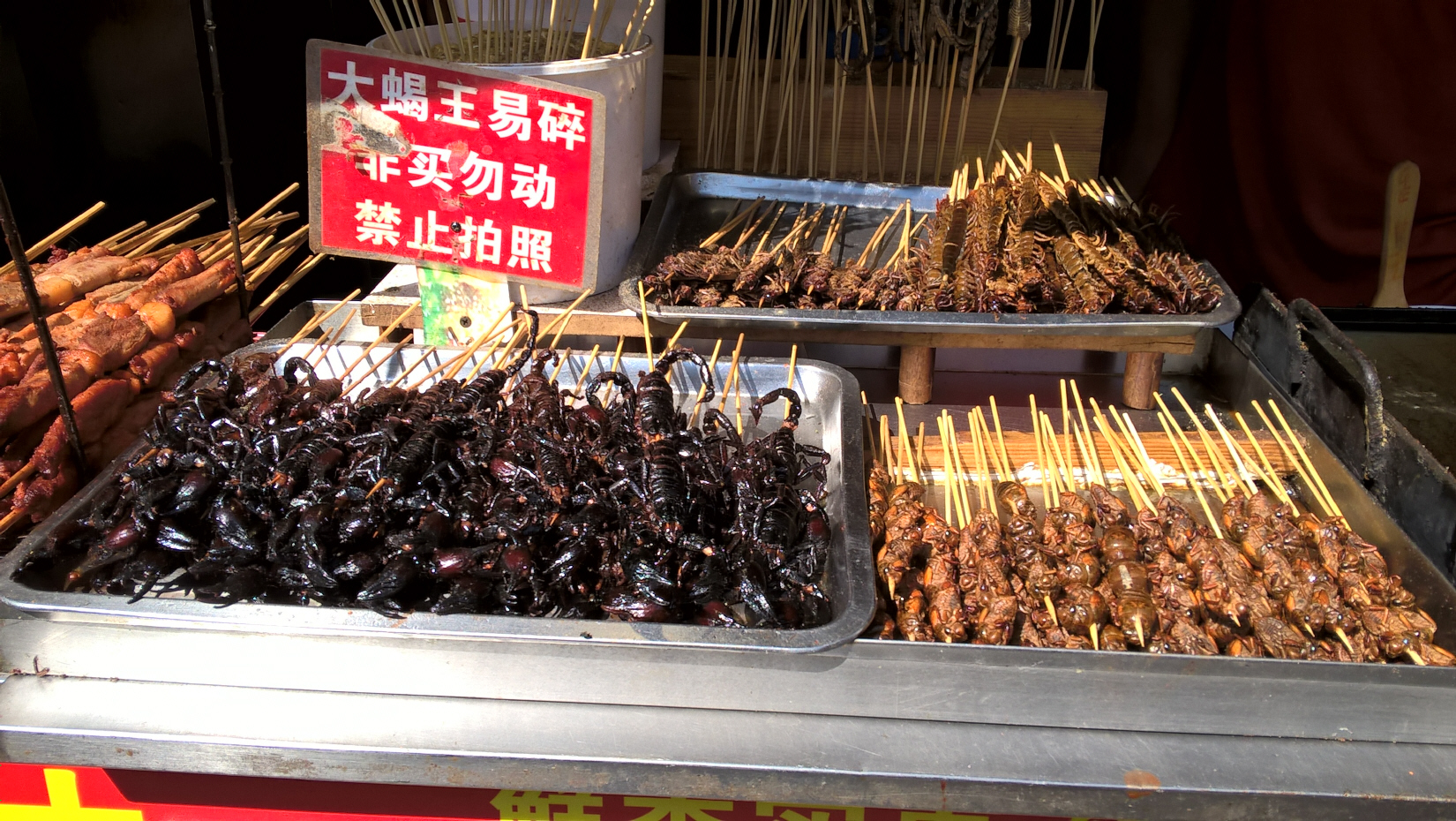
I never did make it to the Forbidden City, Beijing’s most famous sight. I was too tired the next morning to get there early, which is when you should go, before the crowds descend. I figured I would just go late in the afternoon after the crowds mostly left, so I went to the Temple of Heaven instead. Each year the Emperor would go to the temple to pray for a good harvest, and that’s pretty much all it was ever used for. It is located inside a huge park, and is quite magnificent, though once again I was constantly wondering how much is ancient and how much has been reconstructed. It all looked far too new and shiny to feel really old. As it turned out, the original temple burned down in 1889, and was rebuilt a few years later. But I’m sure it looks very much like it did when it was freshly built in the early 1400’s. It’s quite a sight, and I stayed on the grounds a long time.
The
Temple of Heaven:
Other buildings around the
Temple of Heaven:
By
the time I got to the great Forbidden City, the huge palace complex where the
Emperor actually lived, and no ordinary Chinese person dared to set foot in, it
was already closed for the day. So I
never got to see a bit of it. That’s
like going to Paris and not even glimpsing the Eiffel –
pretty ridiculous. But by
then I was kind of fed up with China, and ready to get on with my trip.
I know, you can’t write off a whole vast country because you had two
great disappointments in a week (besides the Great Wall, what they had
done to the big arch outside of Kashgar was the other one).
I’d still love to see Guilin, Xi’an, and Tibet – but I can’t help
but often feel that China just messes up everything it should be trying to
preserve. Tokyo was next!
The
Ginza –
Tokyo's main street:
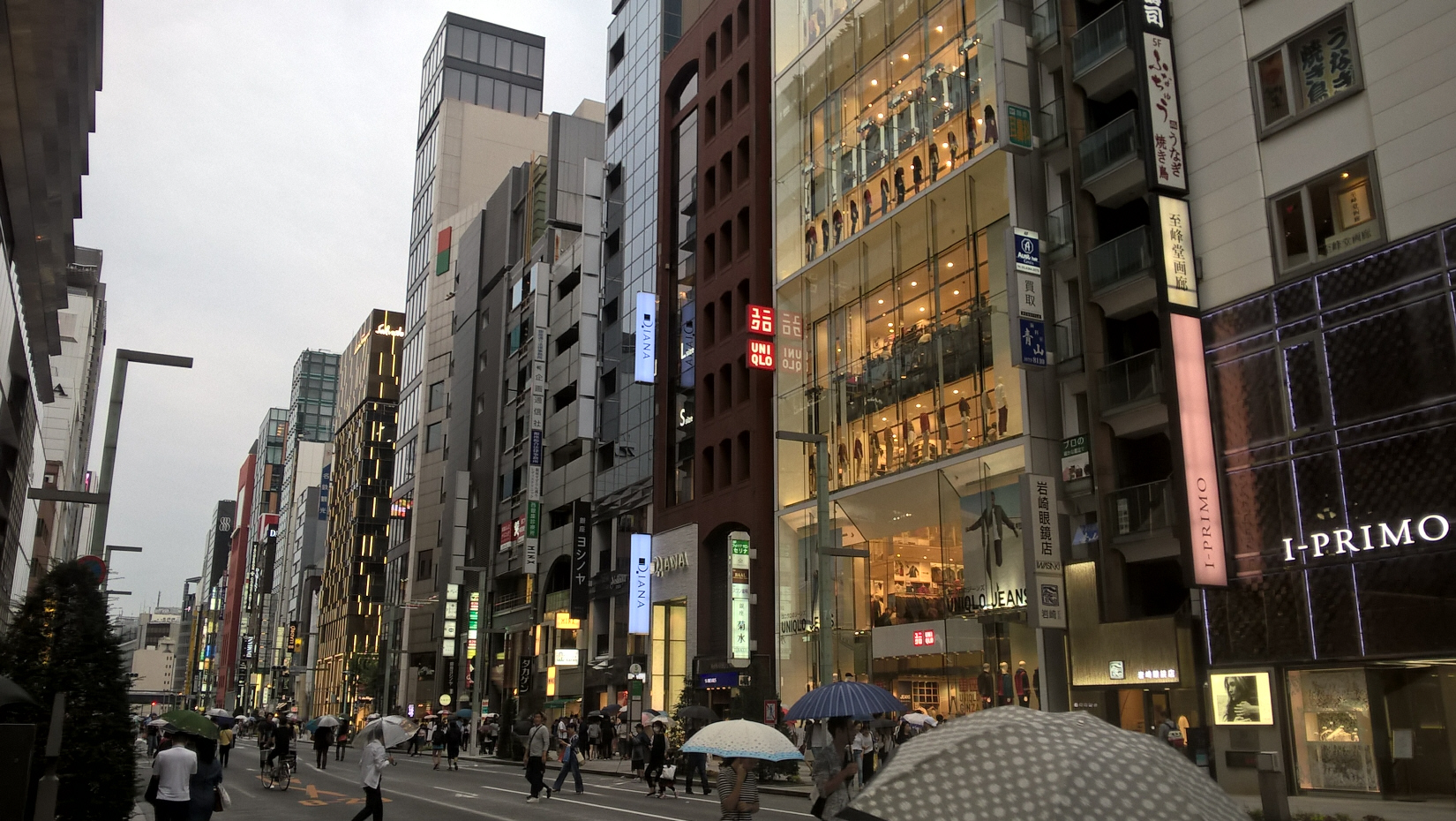
And what a contrast. Even though Tokyo doesn’t look much different from Beijing architecturally, as soon as you arrive you just know somehow that you are in the safest, cleanest, most civilized big city on earth. In fact, you’re in the biggest city on earth, with a population of over 20 million. Everything just works. People are so well-mannered. There is no litter, no graffiti. Even smack downtown, the traffic isn’t bad at all. I liked it instantly. Even the toilets are amazing.
This
is what you get in the modern new Beijing airport –
and one at the
Tokyo airport,
complete with warm-water spray, blow dryer, and deodorizer.
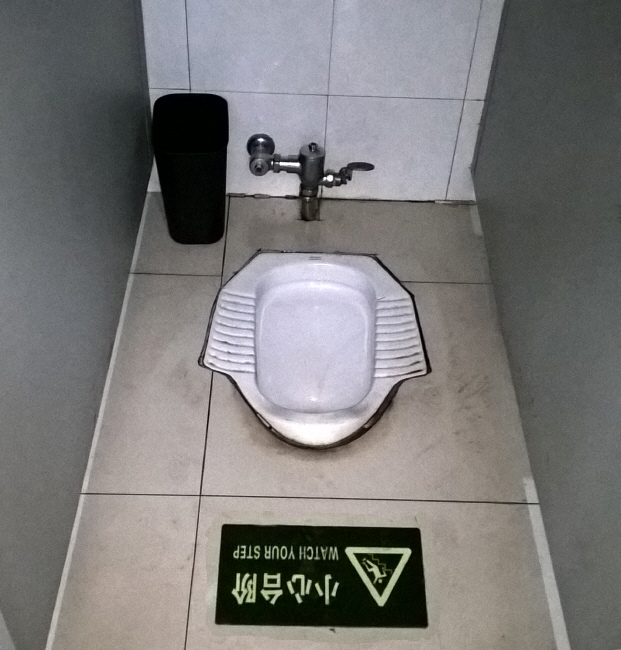
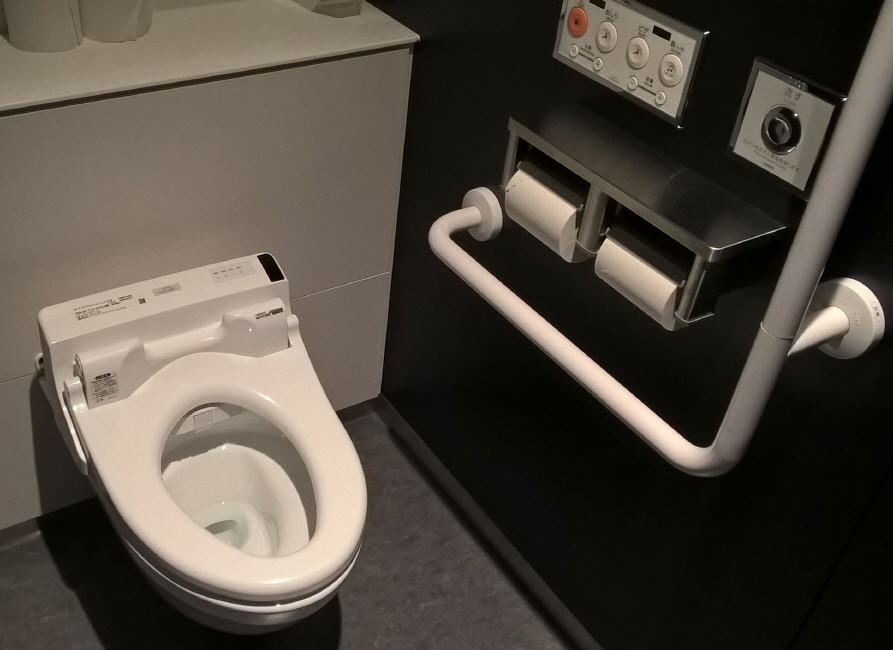
In one big shopping mall, I was fiddling around with the controls for the fancy commode, trying to make it flush. There were all kinds of buttons – you can spray warm water all over your rear end, adjust the water pressure, change the direction it sprays, turn on a blow dryer, activate a deodorizer, and even play music to cover up any sounds you might make. But where was the flush? I never did find it – I punched some random red thing, then suddenly realized it was an emergency call button. Uh-oh, I better get outta here quick! So I strapped up and ran out of the room just as a security guard was running in to save me.
Strangely enough
though, as I found out, there really isn’t very much to see in Tokyo.
For such an enormous city, there is very little of the old Japan there,
very little that is old, quaint, or historical.
Much of whatever they had was destroyed from bombing in the war, so
practically the whole city is from the 1950’s on up.
Beijing has more that is extremely new and modern, though the general
quality of ordinary buildings is much better in Tokyo.
The one big, ancient temple in the city, the Sensō-ji Temple, supposedly completed in the year 645 and Japan's most popular religious
site, like the one in Beijing is totally rebuilt. I figured that out as I was leaning against a column.
“Why does this feel like concrete?” I wondered.
I knocked on it. Because it
was. I soon noticed way too much
glass and steel, too. But still, it
gave a good idea of what an ancient temple complex was like, helped out by the
fact that lots of people like to wear traditional clothing like kimonos when
they go there.
I stayed in a capsule hotel! I remember reading about them way back in the 1980’s when they were first invented in Japan, and thought some day I’d like to stay in one, just for the experience. You sure don’t stay in them for comfort or convenience! Their whole excuse for existence is totally
because of price and location. I wanted to stay in the Ginza area of Tokyo, their main downtown and most famous area, but any normal hotel there was over $200 a night. Anything less than $100 was far from downtown. So the solution was a capsule hotel – right in the Ginza, at $30 a night. The “room” is about 7 feet by 4, with a light and a fan. There are a couple hundred capsules on each floor, one person per capsule, with men and women on different floors. You put your stuff in lockers, including your shoes, and they provide slippers and pajamas, even toothbrushes, razors, earplugs, and Q-tips. The bathrooms and showers are down the hall, and kept spectacularly clean – no people have more of a cleaning fetish than the Japanese; in fact you have to leave the whole hotel every day from 10 till 4 so they can scrub it top to bottom – the one thing I really didn’t like about it! Sometimes I wanted to sleep late. Even though there are people sleeping on each side of you, across the aisle from you, and either above or below you, there was no noise problem at all – the Japanese are amazingly quiet and considerate, even the college kids, which make up most of the customers plus some businessmen. There is a lobby where people go for TV and snacks – it was the only time on the whole trip where I actually met people and had some nice conversations with other travelers.
My hotel room!
Would
I recommend a capsule hotel? Umm…
not sure. It’s a hassle not to
have all your things in the room with you, to have to crawl in
your room either on hands
and knees or up a little ladder, and to get dressed out in the locker room; and
it wouldn’t work in lots of countries at all because the people would be too
rowdy and noisy, straggling in late at night – but it works in Japan.
However, for location and price, I’d do it again, though I did sneak an
extra pillow out of a neighboring capsule every single night.
The most popular tourist attraction in all of Tokyo, though, was never meant to be one at all – the Tsukiji Fish Market. (That kind of lets you know there’s not much to see in the city, if an old fish market is the main attraction.) My hotel was just a couple long blocks away, so I went there each morning. People line up by the hundreds for sushi for breakfast – sushi that was swimming just a couple hours earlier. It’s amazing to see all the crazy critters they sell from the sea. The smells and sounds of the world’s largest fish market attract millions of tourists a year; but actually it’s just supposed to be a serious place of business, and it’s easy to get in the way of all the mad commerce going on, the fork lifts, trucks and vans. Fish has to be processed, sold, and delivered each day very quickly, for freshness. So the Tsukiji market won’t be around much longer, they are building a huge new fish market on the edge of
the city that will be more efficient and modern.Japan has a thing for fake food. Many restaurants have a display window on the street showing the dishes they serve -- all plastic. You know it's not real food, because of how it's slanted! Producing fake food is a billion-dollar industry in Japan, and a rather amazing art, too.
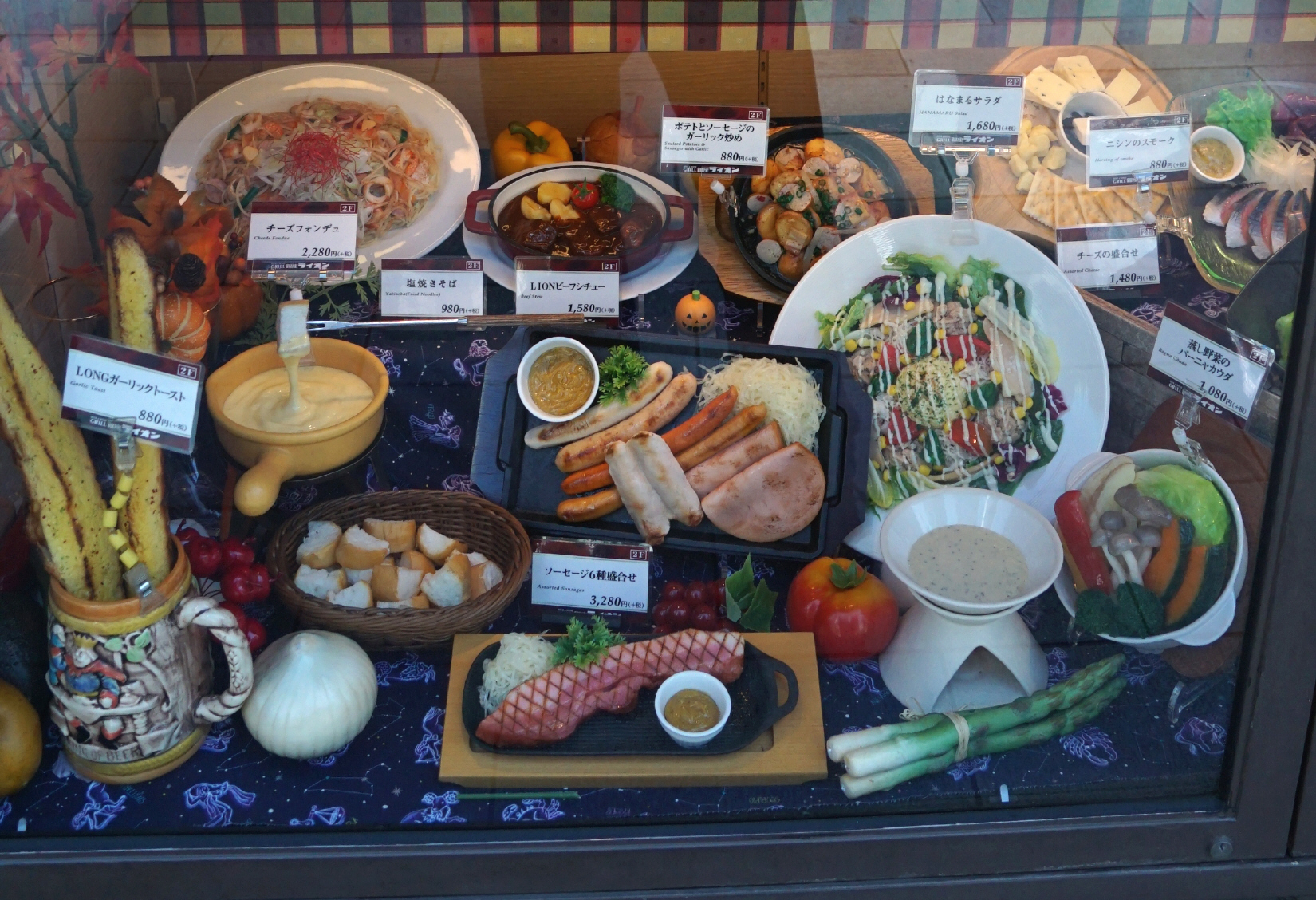
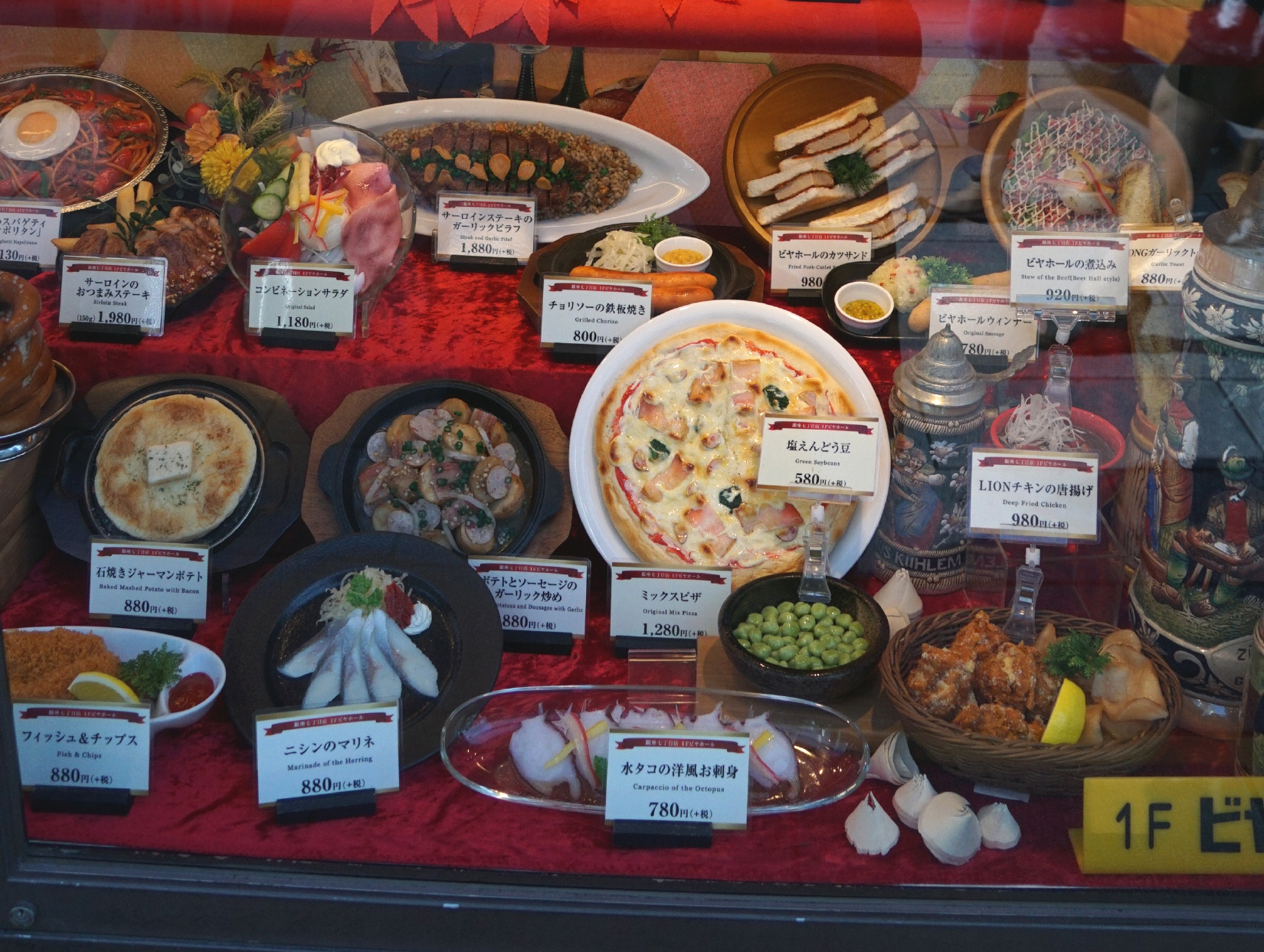
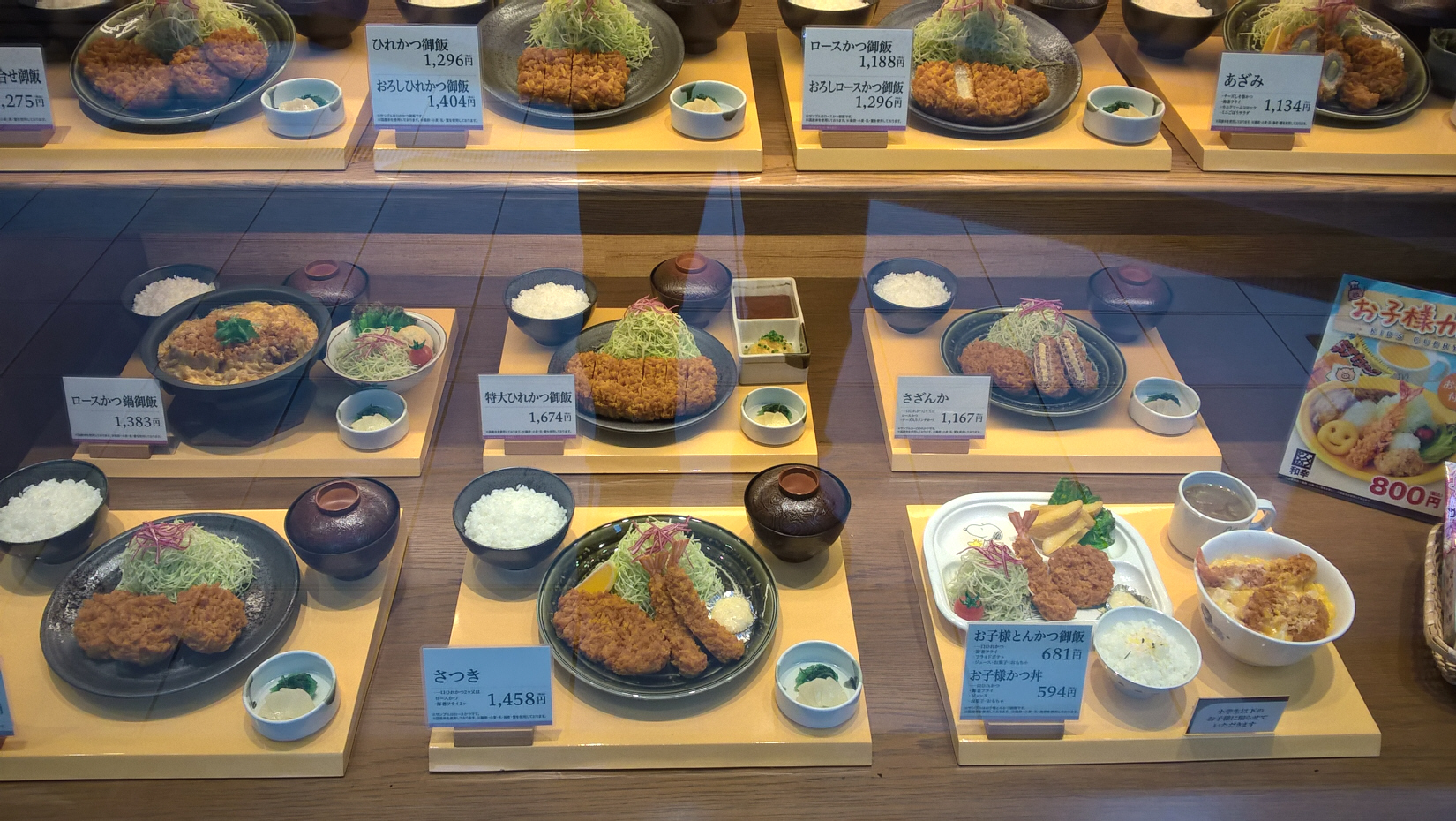
My next-to-the-last day was a rainy day, the only one of my whole trip. I had thought about taking a bullet train to Mt. Fuji, the magnificent perfectly cone-shaped snow-topped volcano, the highest mountain in the country. But to get up on the mountain would mean joining a tour (oh yay), and besides, I would be able to see nothing in the rain. So a rainy day means – it’s a museum day! I like museums, but I seldom go to one if I only have a few days in a city, because I like to just wander and see the city itself, and the people. But rainy days during travel are made for museums. I chose what seemed to be the main one, and therefore the best one – the Tokyo National Museum, set in a prominent position inside a large park north of downtown. It was Japan’s equivalent to our Smithsonian, I figured – the ultimate museum for the whole country, showing the best of the country’s long and colorful history in art, sculpture, and ancient artifacts. I read a few rather ambivalent or somewhat negative opinions online about the place, but I figured they were just from some old grouches who were dragged in there by more cultured individuals. But no. I have never seen a worse national museum in all my life. After borrowing an umbrella from the hotel, and getting my shoes so soaked that they squished for days, I found myself inside the most boring place ever – even the building was ugly. Great vast rooms would only contain seven or eight articles in the whole room – the rest was just air. Others would contain dozens of the same thing, like samurai swords – about which most people would think, seen one seen ’em all. It was the dreariest possible museum experience. It boggles the brain that a major country with such a long, colorful history can’t put together a better museum than this – you’d think they would have one of the world’s greatest, and they should. This place just sucks the energy out of you. I had to sit down a while before leaving to work up some get-up-and-go.
Then
I discovered a lovely place. As so
often happens in world travel, the sights you have great expectations for turn
out less than you expected, but some place you just stumble upon and knew
nothing about turns out to be amazing. In
the same large park where the museum is, I found an ancient little temple,
sitting alone in the rain, with nobody else around. There
was a long sidewalk leading to it, lined with trees, statues and old iron
lampposts. Off to one side, and easy
to miss, was some kind of a stone memorial, with fresh bouquets strewn around
it. A little flame was burning
inside it. I read the plaque.
Wow….
The flame was started by the bomb that was dropped on Hiroshima in 1945. A man’s house there caught on fire, and some burning wood was taken from it, and was never allowed to burn out. After a few years the flame was transferred from wood to natural gas, a more reliable source of fuel. Later, a similar flame from the bomb that fell on Nagasaki was blended with it. Now the flame is enshrined permanently in this little monument. Incredible!
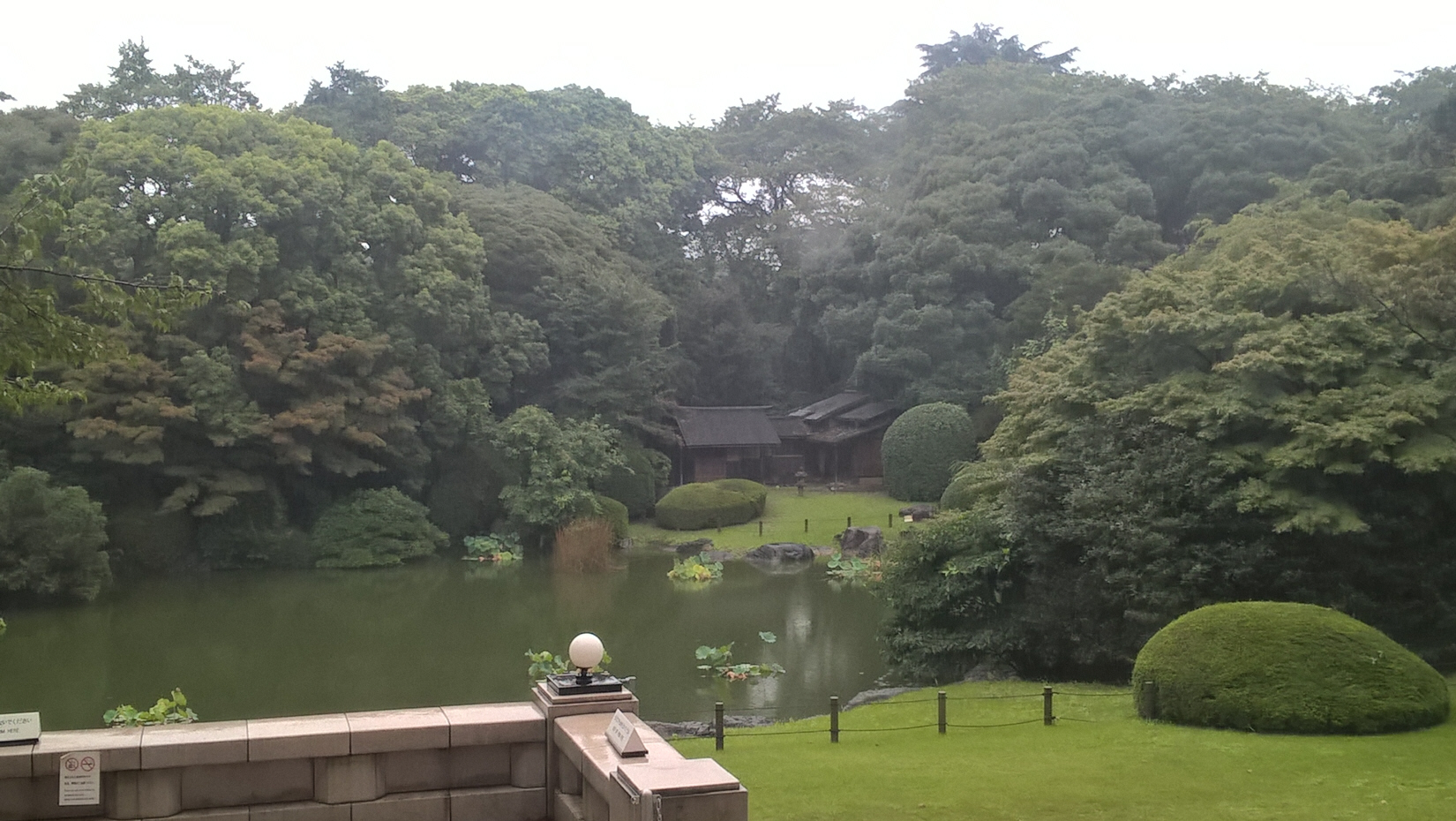
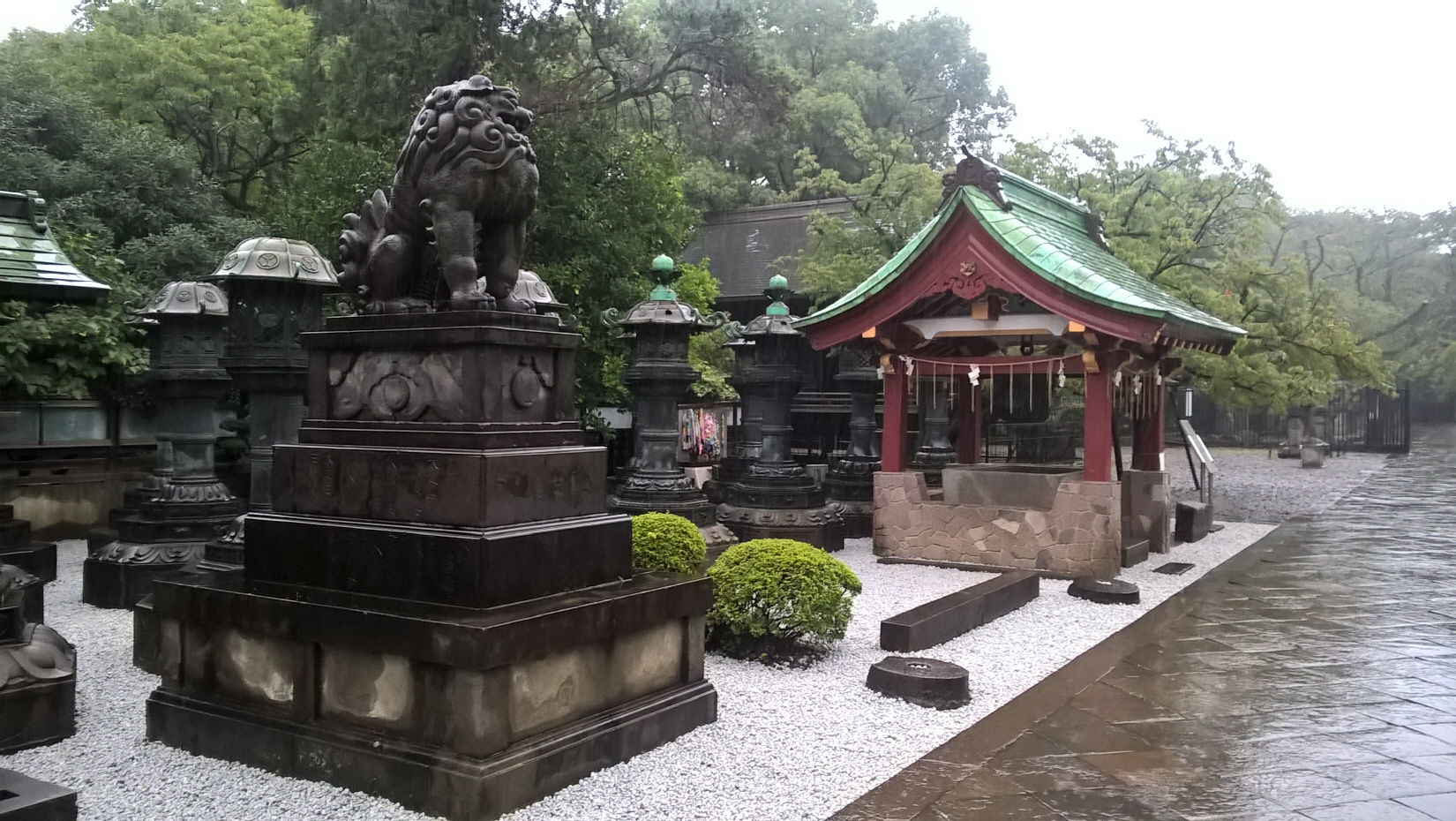
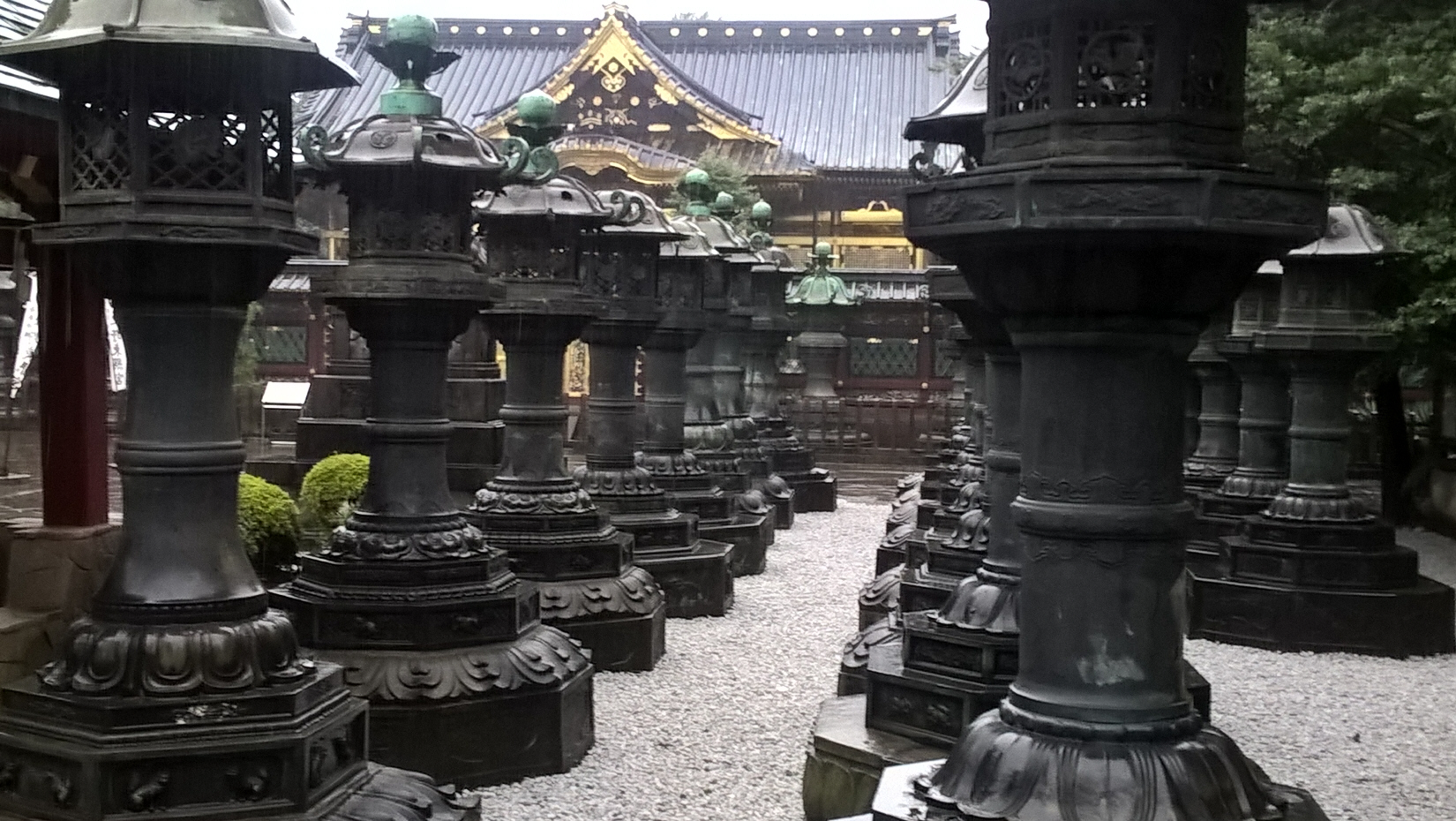
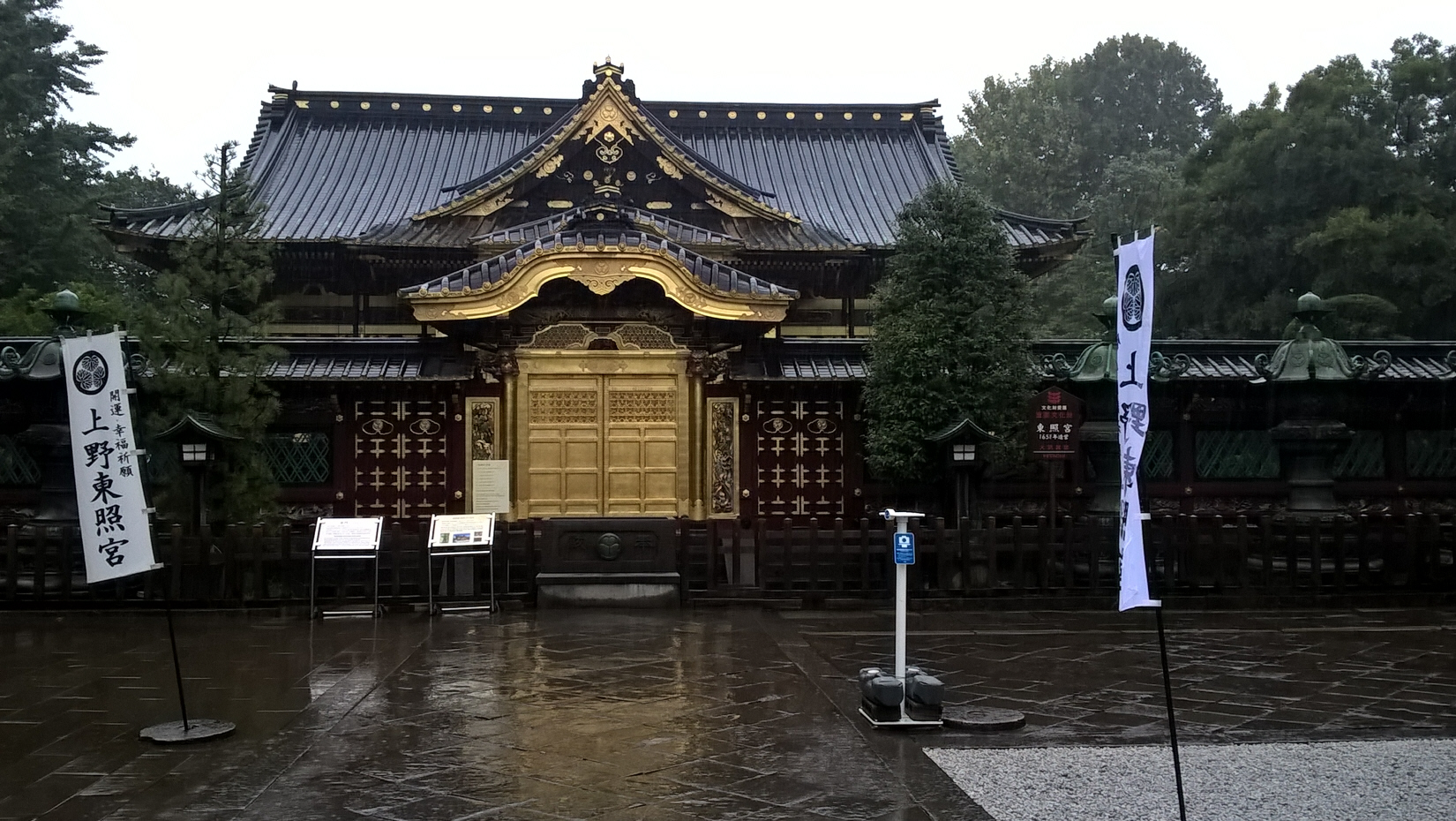
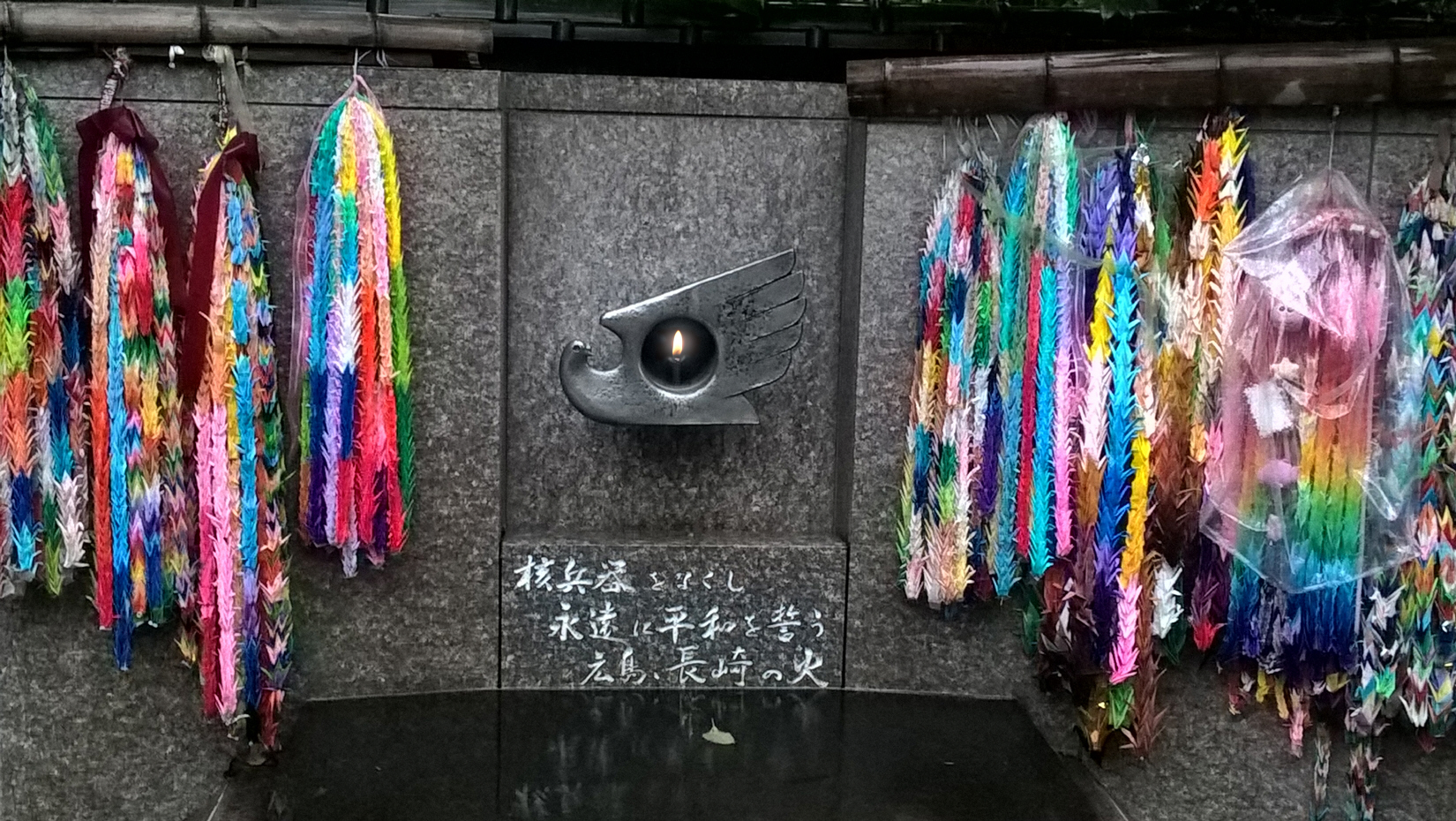
Tokyo, and most of Japan, has no street names. Instead, the city is divided into districts, which are divided into zones, which are divided into wards, divided into neighborhoods, divided into areas, divided into blocks – or something like that. Then each building within the block has a number, though in no particular order – they get their number according to when the building was built,
so an older building has a lower number than a new one. So finding a particular address is pretty much impossible for a poor foreigner. You are better off just figuring out the nearest subway station, and getting directions from there. But still, since any station has several exit staircases, you're quite likely to wander in the wrong direction when coming up to ground level. Nothing confuses your sense of direction more than being underground.Getting from downtown to the airport was the only part of the whole trip where my good transportation plans got dramatically messed up. Whenever you are leaving a country, you try to get rid of all of
that country's money in your pockets – it won’t do you any good in the next country, and to get it converted will cost you a certain percentage, which you’ve already lost once when you got it converted from dollars in the first place. I had my trip to the airport all planned out down nearly to the last yen (which are worth less than a penny each). I would take the subway to a certain station south of town, and then catch the monorail to the airport. A monorail, cool!! That was going to be fun. But my subway pass had expired! The gate refused to open for me. I walked down a few blocks to another subway line – same thing. I didn’t know how to put more money on the pass, or how to explain my problem to the official behind the counter, so he came out, plucked my last 500 yen coin out of my hand and popped it in the machine and recharged my pass. No! Not what I wanted! Now I had way more money on my subway pass than I needed, but not enough to pay for the monorail, and I had to be to the airport in an hour! I got on the subway train anyway, figuring all I could do was find my way to the monorail station, look for an ATM, and withdraw and convert whatever minimum amount of dollars I could to yen – what a hassle, and then I’d be stuck with a bunch of useless foreign money. I wondered if there might be some other way to get to the airport, so I asked the first person I saw on the subway who looked foreign, and therefore possibly English-speaking. “Just stay on this train,” he said. “This one??” “Yes, it goes to the airport.” His English wasn’t so good, so I wasn’t sure if I believed him, and he got off in a few stops. So I was worried. Soon though I noticed a chart over the doors showing Haneda Airport as the last stop on the route, and several people had suitcases. But subways are slow, make a lot of stops, and the airport was many miles out of town. Suddenly though, the train stopped stopping at each station, picked up speed, and blasted straight through next dozen stations at full speed – and we were there. How did I just accidentally manage to get on the one train, out of the world’s largest subway system in a city of 20 million people, that just happened to be the express train to the airport? But I did. Shucks, no monorail though.For the first time in my life, I had a first-class plane ticket! In fact, it was seat number A1, on Hawaiian Airlines. All of my flights, except for SCAT and the ones in China, had been free because of my airmiles program. A first-class ticket for some reason only cost a bit more than a regular one on that particular flight. Since I was going halfway across the Pacific to Hawaii, in the dark, I figured it was worth the extra in order to get a reclining seat and some sleep on the plane for a change. I would arrive in Honolulu the next morning, with just a 10-hour layover there, so I sure didn’t want to waste my first time in Hawaii
sleeping half the day in a hotel. I wanted to rent a car and drive clear around the island!The best thing about first class was the special upstairs lounge at the airport, where you get a free all-you-can-eat buffet, and can go eat it by huge windows overlooking the runways, watching the planes come and go. On the plane, the seat was amazing – it unfurled and unfolded in all kinds of ways, and soon I was lying completely flat with a little wall around me, with a pillow and a blanket. This was going to be great! But no. I tossed and turned and wiggled and twitched and twisted and squirmed
and flopped and flounced for seven hours! Made no sense at all, it wasn’t really uncomfortable. I might as well have just saved the extra air miles and sat up and watched movies all night. I got to Hawaii all bleary, but yay, I was back in America!I got my rentacar, and headed for the capitol building. That just had to be the first thing to go see. I had already been to all 49 other states and had seen all 49 of the capitol buildings; finally I would finish my collection! First though, I saw the lovely Iolani Palace, which is right in front of the capitol – the only royal palace on American soil, built in 1879. At the time, Hawaii had great plans to be a modern nation, and the palace had electricity and telephones before the White House in DC even did. But the only reigning monarchs to ever live in it were King Kalakaua and later his sister Queen Lili‘uokalani, before the monarchy was overthrown in 1893. Soon after, Hawaii became American territory, and the palace was then used as the capitol until 1969, when the modern new one was built behind it. The new capitol certainly doesn’t look like anybody’s idea of a typical capitol, but Hawaii is hardly a typical state. The building is surrounded by
a water moat, symbolizing a land surrounded by the sea. It has a rectangular shape around an open courtyard – therefore the area that is normally occupied by a dome in most capitol buildings is left open. It is said that Hawaii's capitol dome is the sky. The
Iolani Palace:
The new capitol of Hawaii:
Between
the Iolani and the capitol are some fabulous old banyan trees, which drop roots
down from their branches:
Across the street from the Iolani Palace is the Ali‘iolani Hale, an older palace that is now used as the state Supreme Court. In front is the famous gold-leafed statue of King Kamehameha the Great, who unified the islands and established the Kingdom of Hawaii. The statue was designed in Florence, Italy, then cast in brass in Paris. It was shipped out of Germany clear around the bottom of South America, where the ship encountered a storm near the Falkland Islands, and then sank after a fire broke out on deck. A second cast of the statue was ordered from Paris. But the first one was rescued by some fishermen and eventually delivered to Hawaii, giving them two copies of the same statue. The second one, being in better shape than the one that had been underwater, is the one seen here. The original one is now set up on the Big Island near the king’s birthplace. A third one was later made, and stands in the US Capitol in Washington DC.
The
Ali‘iolani
Hale:
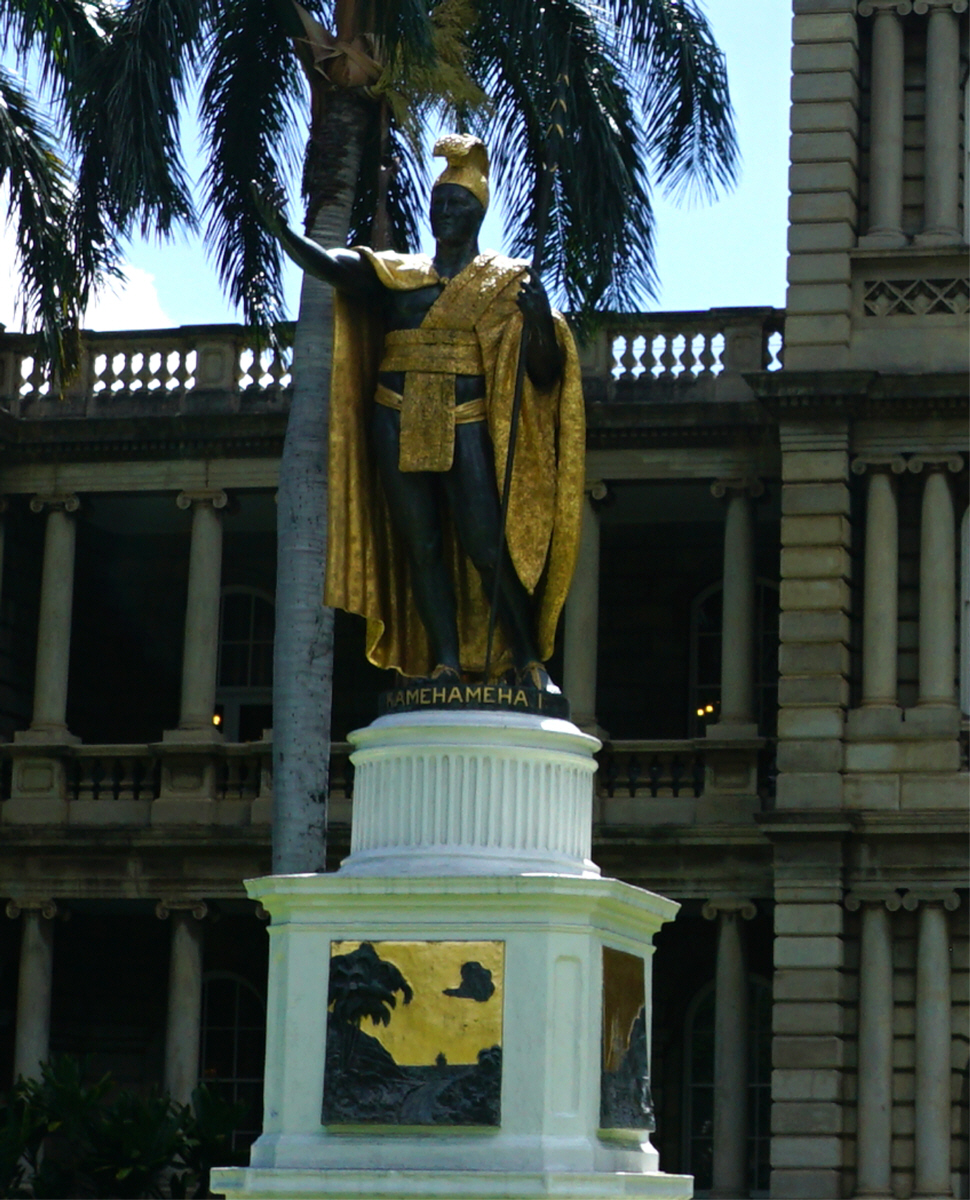
That afternoon, I drove most of the way around the island of O‘ahu, which was amazingly scenic along the east coast. By the time I got back to Honolulu, it was dark, and I was quite ready for a nap; so I parked at a Walmart, crawled into the back seat, and slept for an hour. I still had to return the car, fly to Los Angeles (two nights in a row with no sleep), and then on home to Oklahoma City. But that part of the trip was uneventful; in fact I don’t remember a thing about it. I was just delighted to be back home, where I slept for the next 14 hours.
*************************************************************************
I knew it would take weeks for the trip to sort itself out in my head, for opinions to be formed, for memories to pop up and settle down. Was it worth all the time, stress, energy, and money? Yes, but more time would have been better. I knew all along it would never be a trip I would look back on as one of my favorite trips ever, like Patagonia or Iceland were, or a place where I feel at home, like France or Austria. It was certainly the most ambitious and varied trip of them all, and I hit five new countries I’d never been to (I’m up to 55 now). But China left a sour impression in several ways, even though I look back on Kashgar as my favorite part of the trip. There are other parts of Japan that would have been much more scenic and historic than Tokyo, like Kyoto and Nara. Many times during the trip I would find myself thinking, “I could have been in Europe!” But still, I had to have the experience – you can't know unless you go. In twenty days, you can only get a small taste of each country, nothing much in depth.
In fact, a round-the-world trip isn't even a very logical thing to do at all, unless maybe you can spend months at it. The main reason I did it, as I said, was because I was halfway around the world anyway for the World's Fair, so I just kept on going; but otherwise, it's kind of silly to do it in such a short time because you spend so much of your time in planes and airports. I found out I don’t much like being in places where I don’t blend in, looks-wise – even in the Emirates, I was wishing I was wearing a dishdasha. I never encountered the least bit of rudeness or prejudice though, quite the opposite really. All the countries I visited have a generally high-level quality of life, with seemingly contented, well-educated populations, which was nice to see – I’m not one of those who insists that, in order to qualify as a true world traveler, you should be just thrilled to spend a month in Djibouti or New Guinea or Bangladesh. I don't have to have great comfort, much less luxury, but I have found that I prefer the highly developed countries, or those with spectacular scenery. One thing is for sure though – after circling the world in 20 days, I'm not going anywhere for another year! (Or until I save up some more free air miles.)